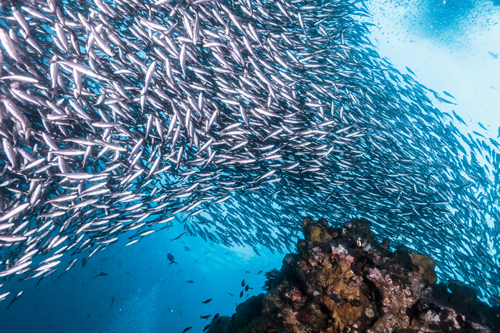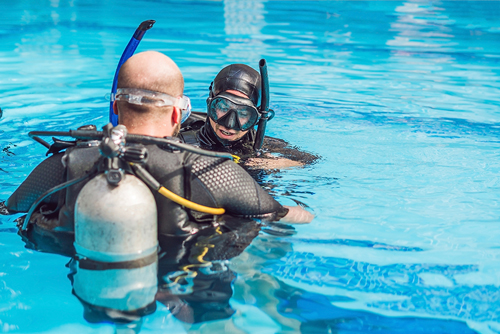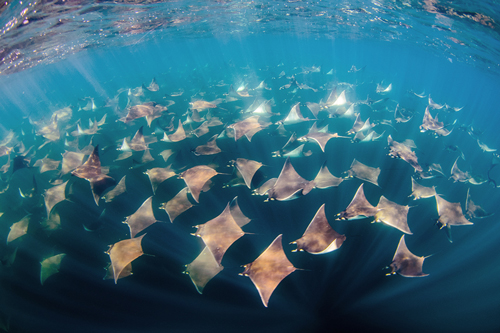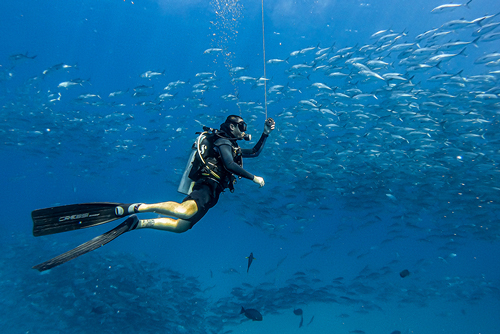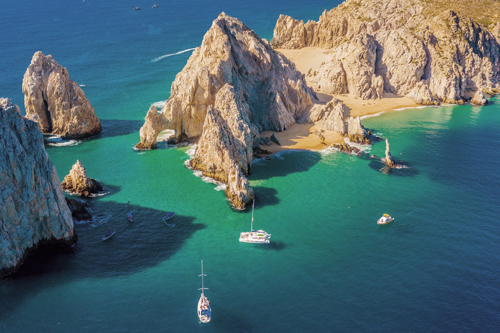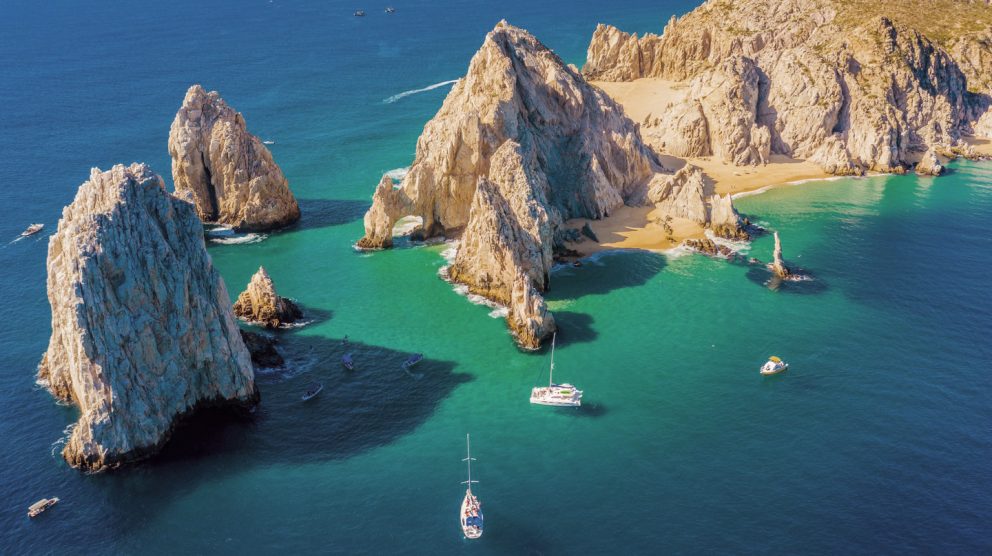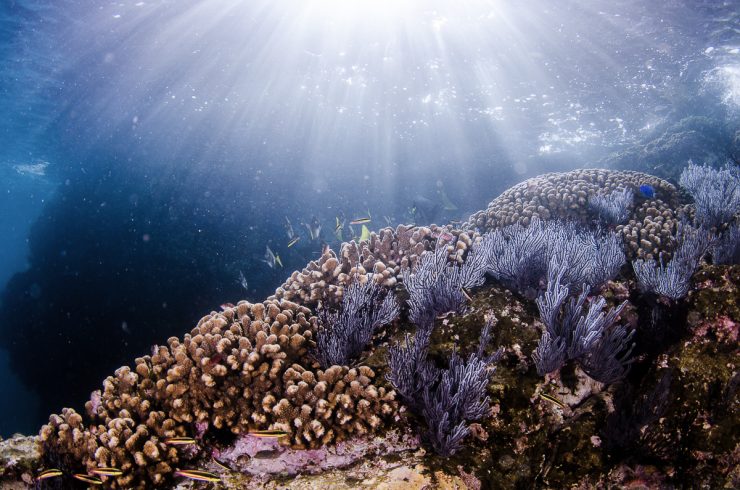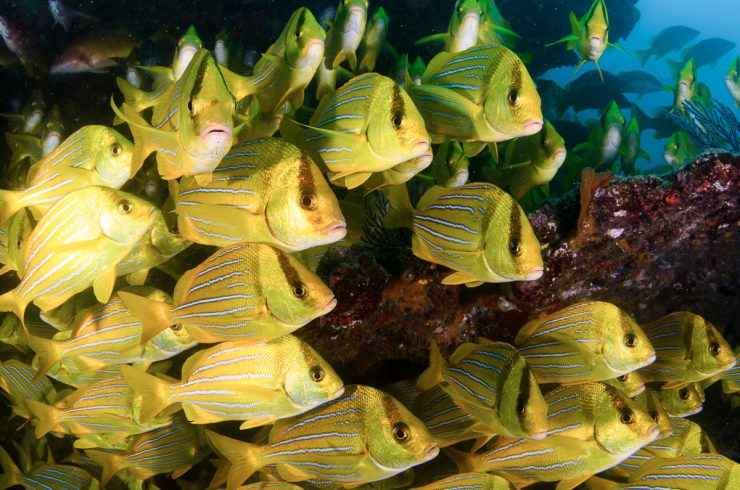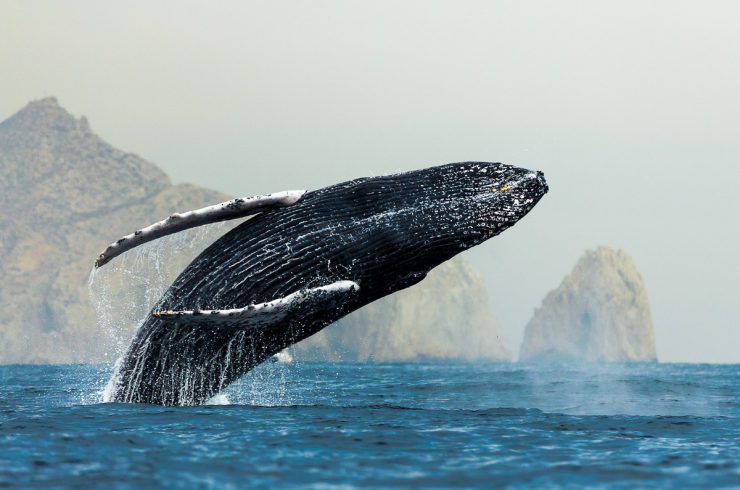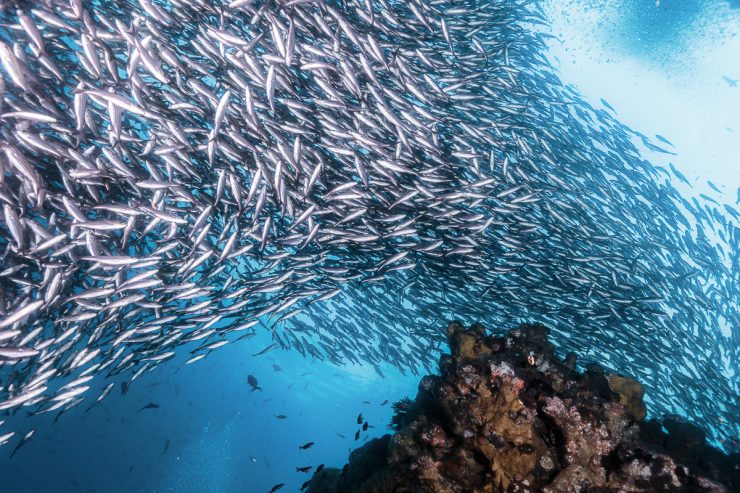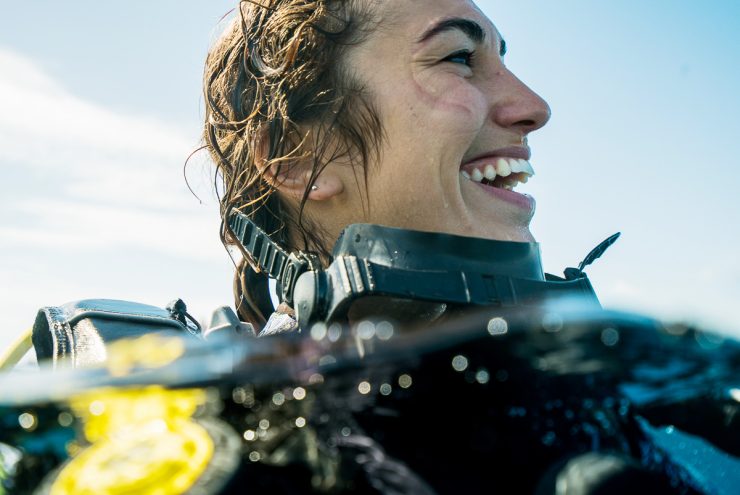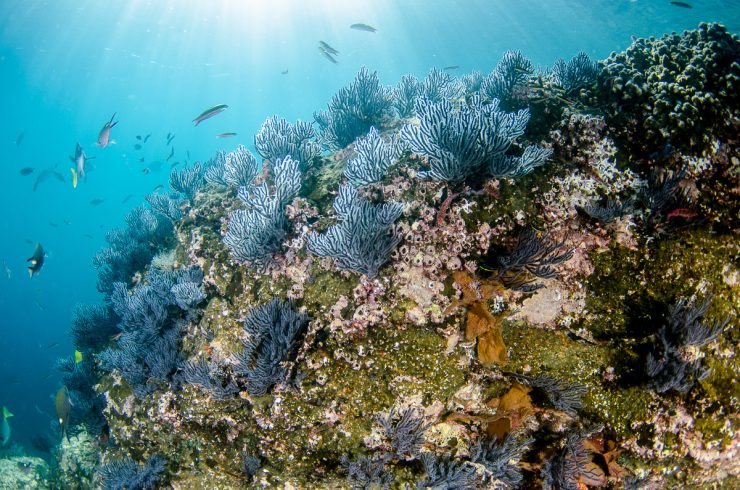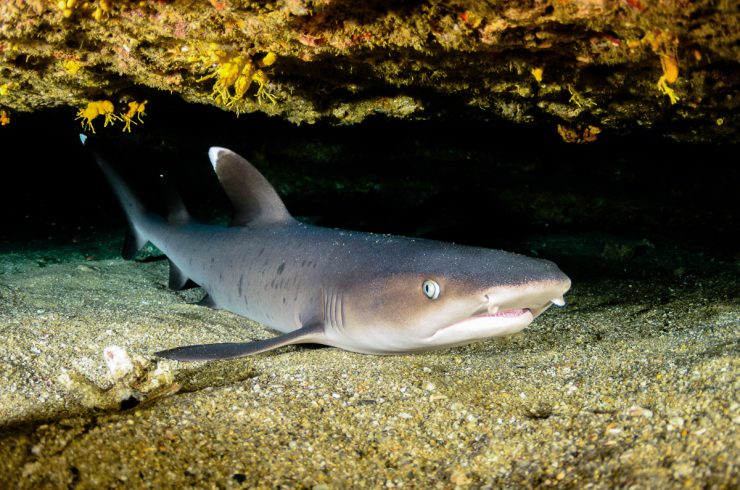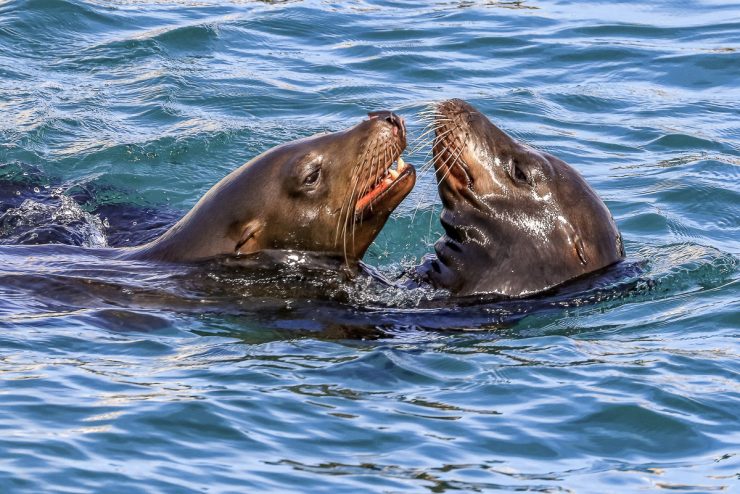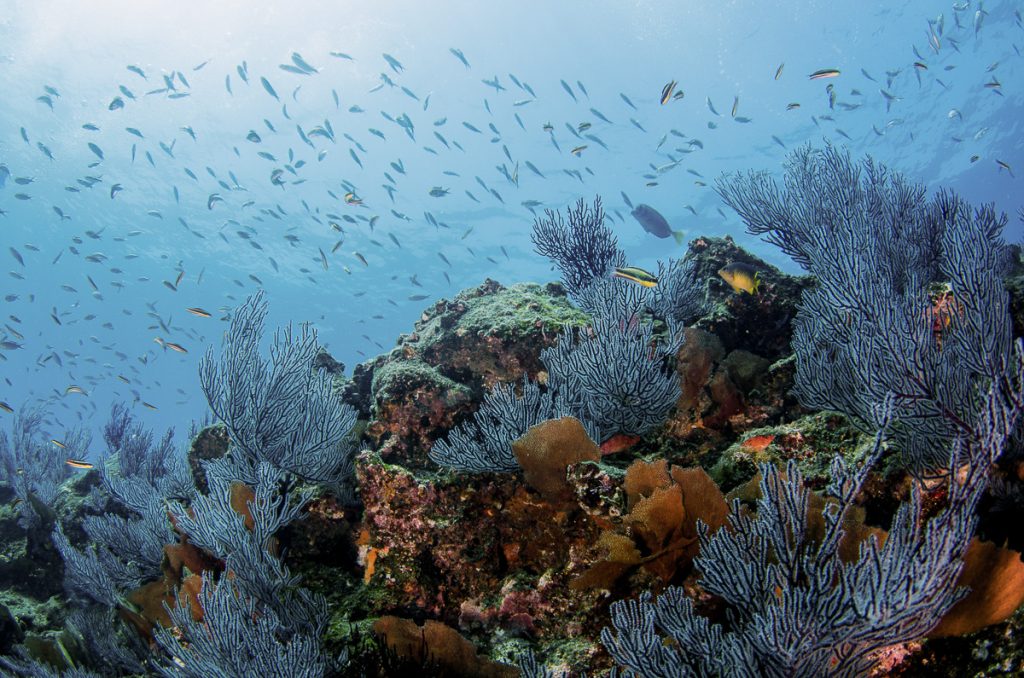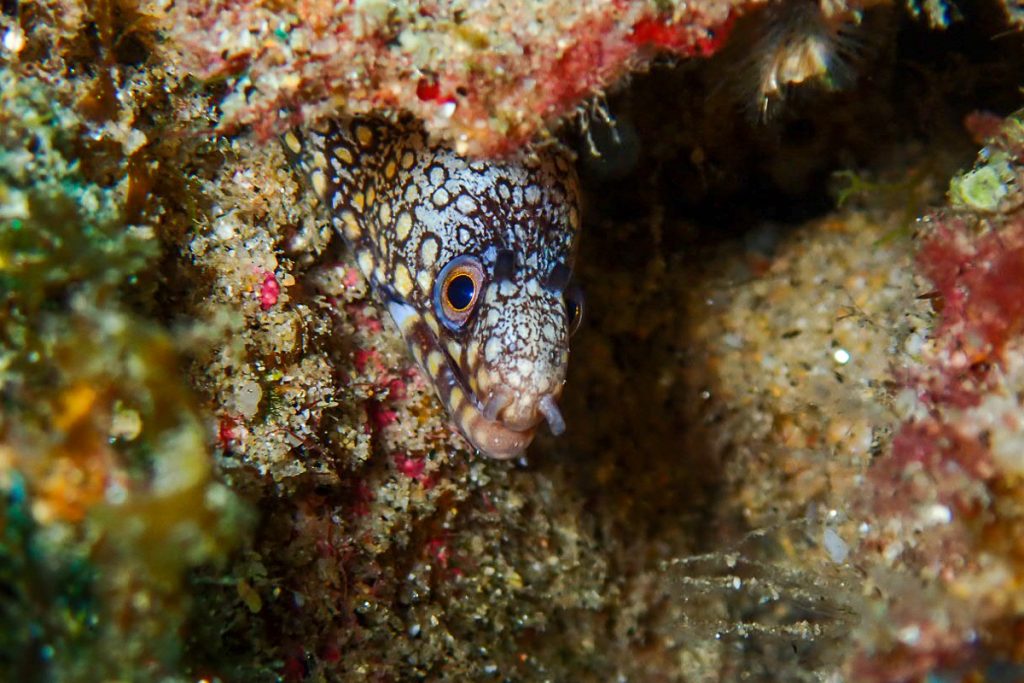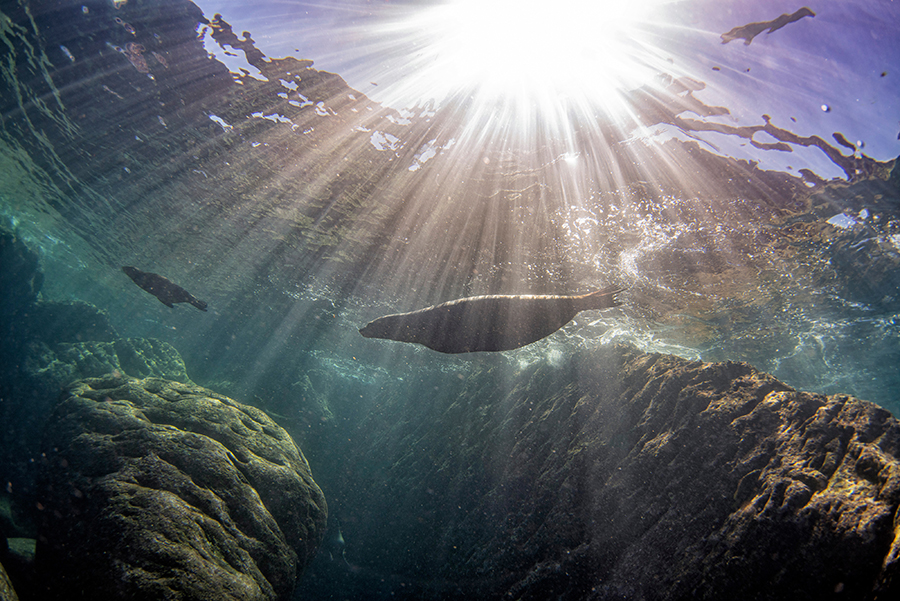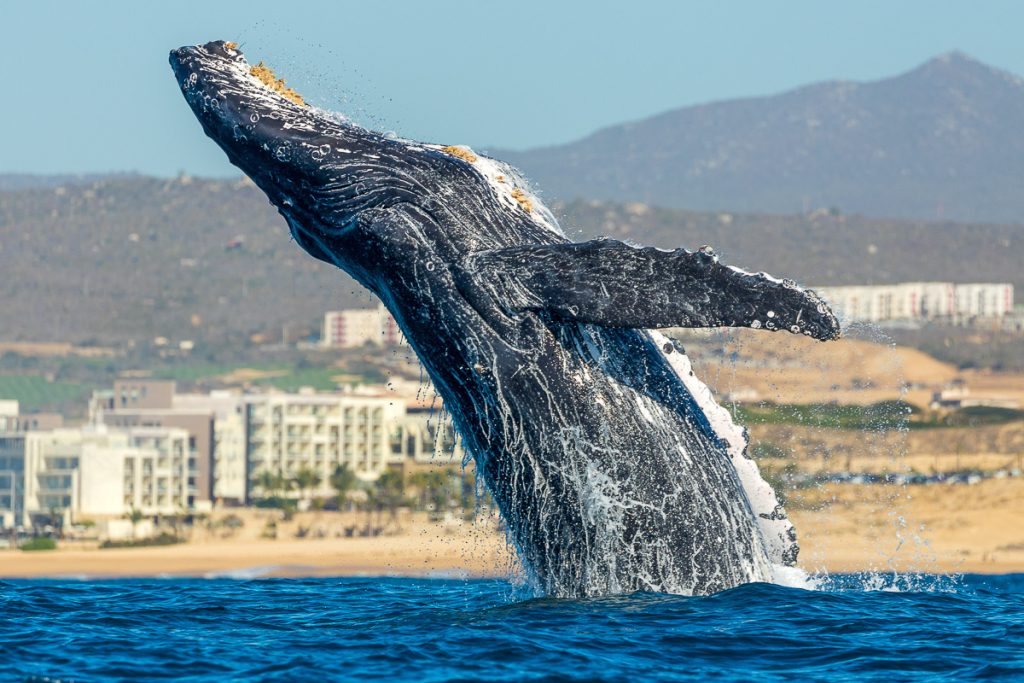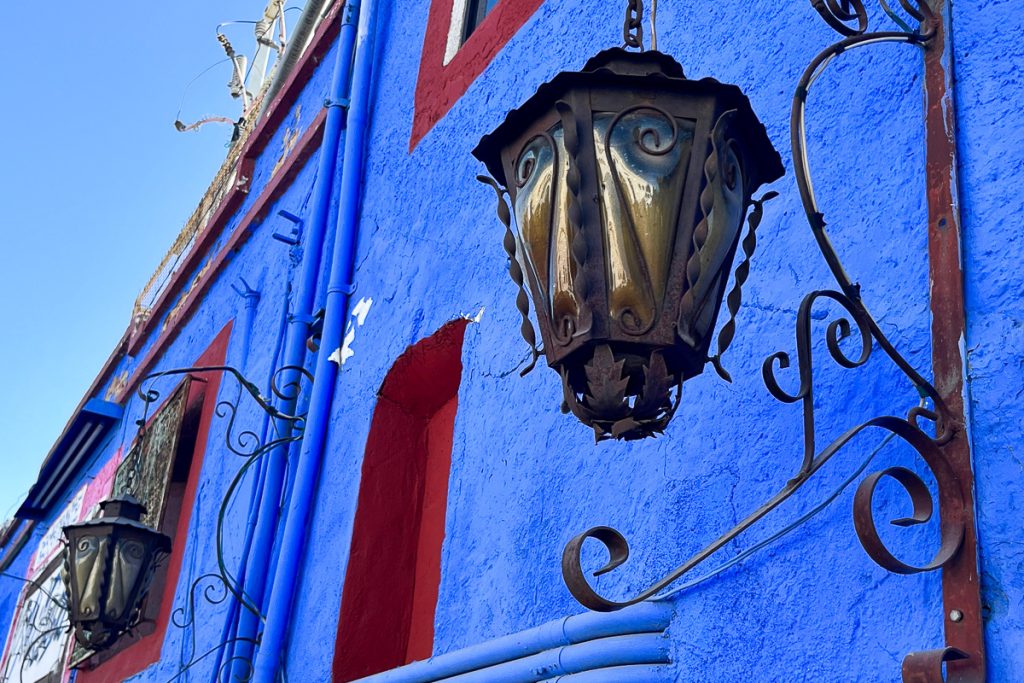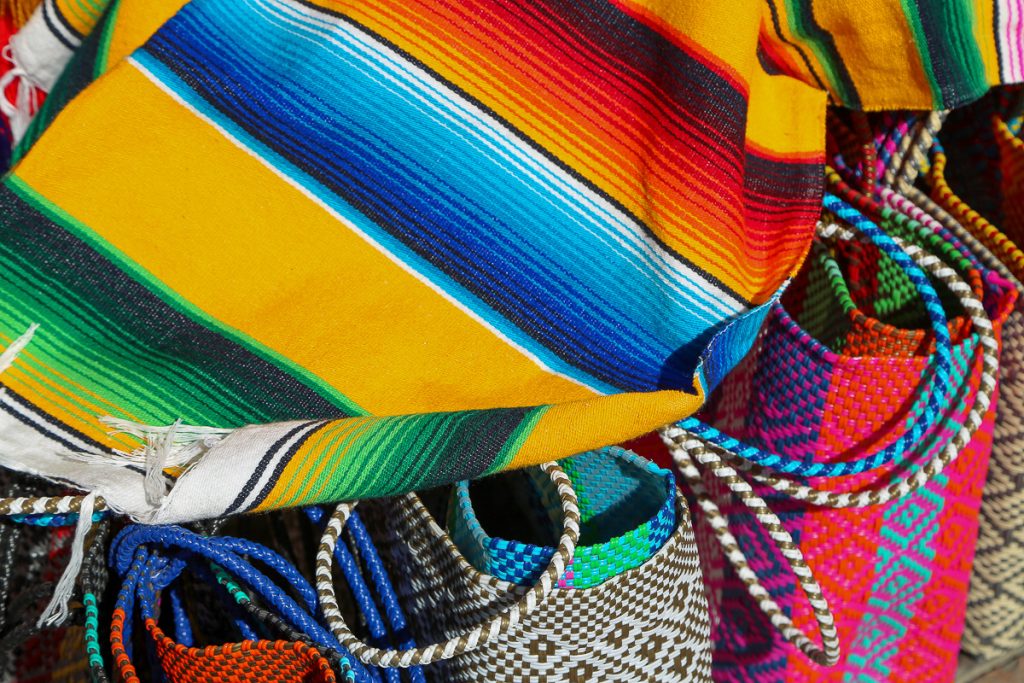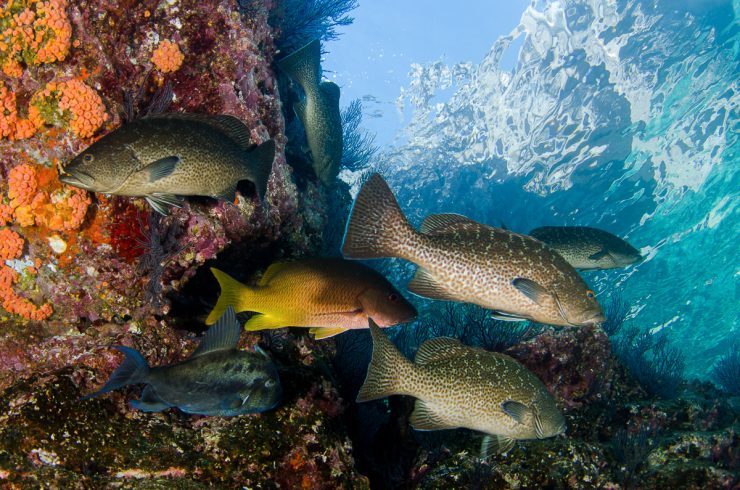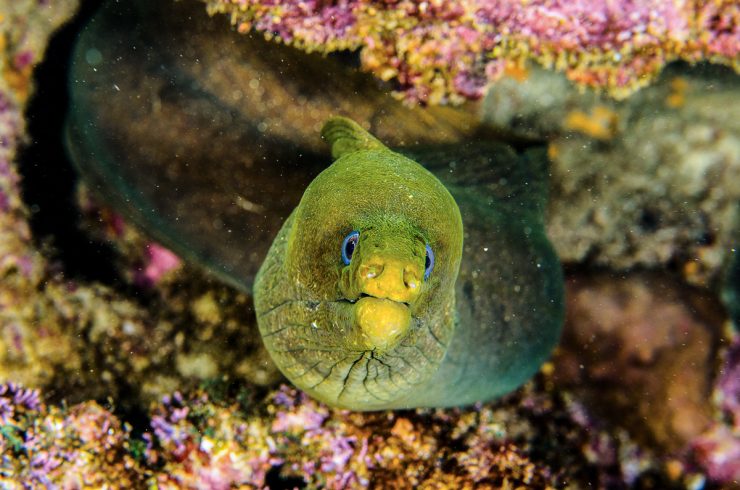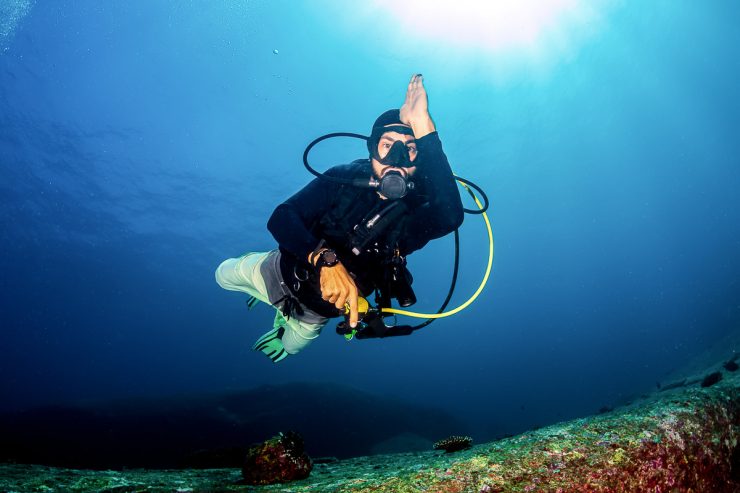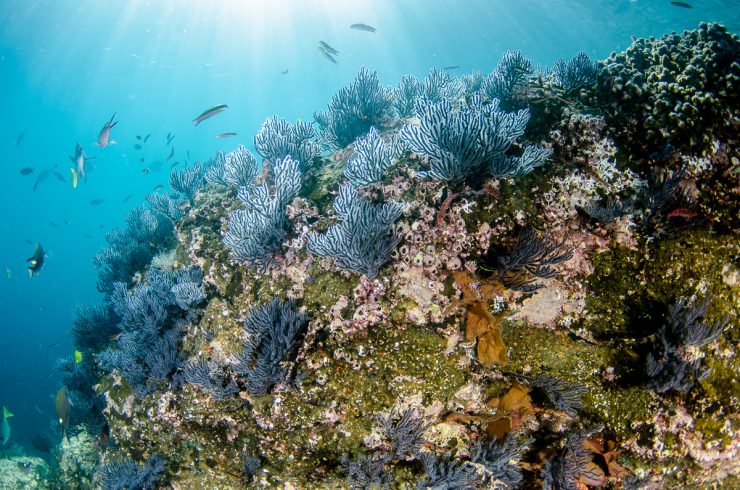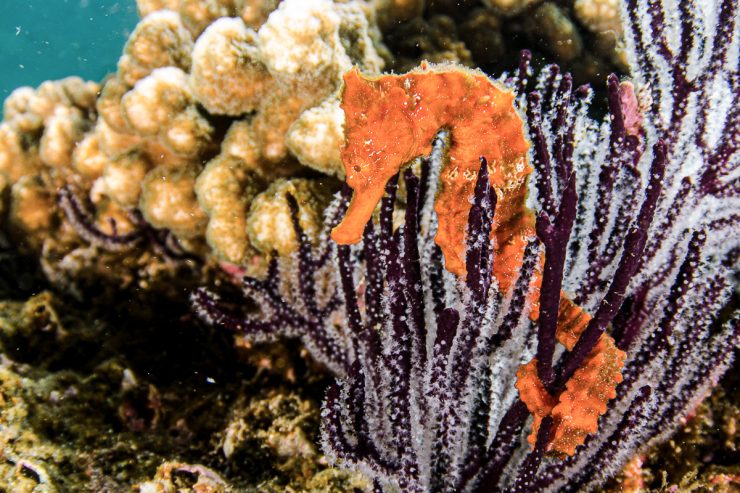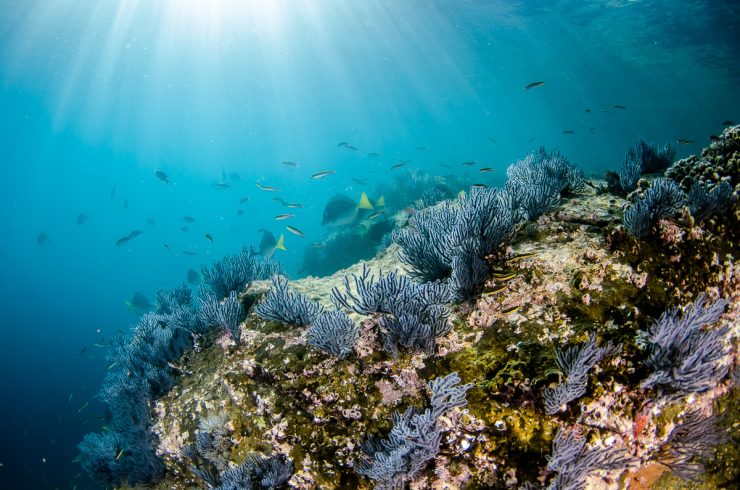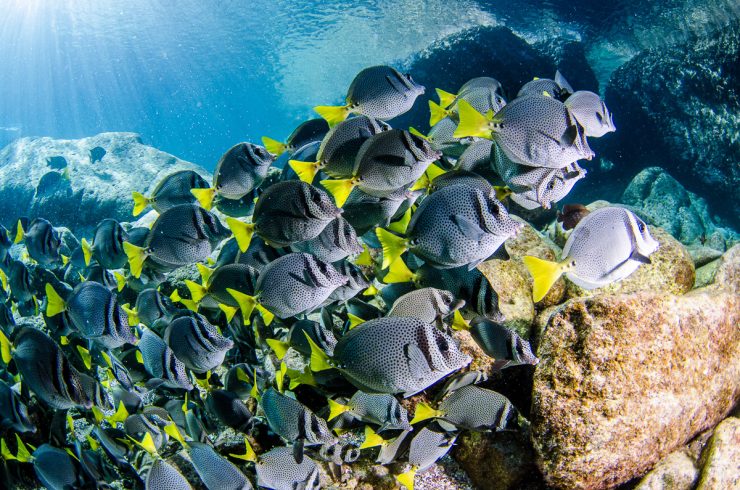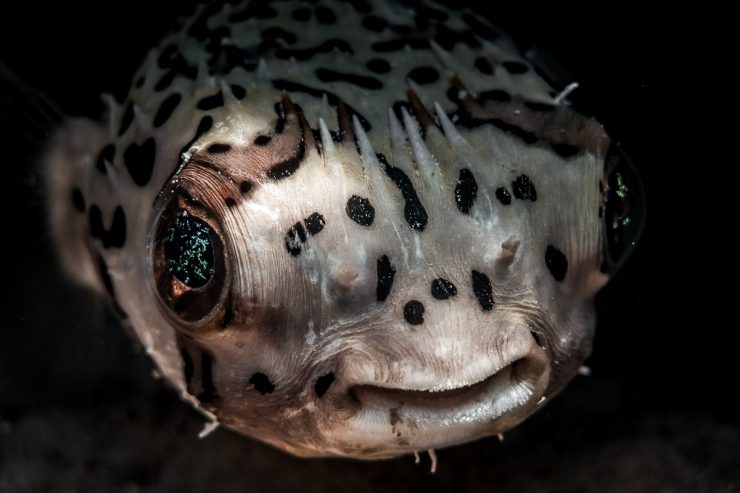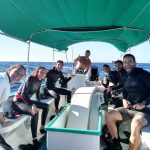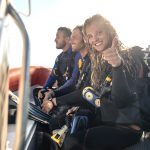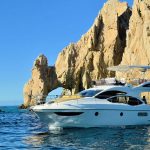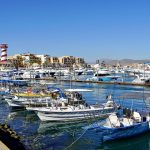Thinking of scuba diving in Cabo San Lucas, but don’t know where to start?
Whether you’re new to diving or an experienced pro, I’ve gathered all the insider tips to ensure your underwater escapades in Cabo are nothing short of outstanding.
For the last decades, I’ve occupied my time exploring the waters of Baja California, and in this Scuba diving guide to Cabo San Lucas, I reveal why I love this remarkable diving destination so much and everything you could ever need to know about diving in Los Cabos.
Destination Overview:
Scuba Diving in Cabo San Lucas
Cabo San Lucas, located at the tip of Mexico’s Baja California Peninsula, offers a perfect blend of adventure and relaxation. Renowned for its stunning beaches, vibrant nightlife, and rich marine ecosystems, Cabo San Lucas is a paradise for scuba diving and snorkeling fanatics.
With its iconic ocean landmarks, delicious cuisine, and year-round sunshine, Cabo promises an unforgettable experience for all divers. Plus, whether you’re traveling with family or flying solo, Cabo is suited to every type of traveler.
What you need to know before diving in Cabo San Lucas
Should you go on a scuba diving vacation in Cabo? Here’s what you need to know before you come and dive with us.
With favorable diving conditions year-round, Cabo San Lucas hosts a diverse range of dive sites suitable for all skill levels and preferences.
Whether you’re a beginner seeking calm, protected coral bays or an experienced diver looking for deep seamounts and underwater canyons, Cabo has it all.
Bordered by the Pacific Ocean and the Sea of Cortez, Baja California serves as a migratory path for numerous marine species.
Scuba diving in Cabo San Lucas promises an unparalleled experience thanks to its remarkable biodiversity.
From Sea Lions to Mobula rays or Hammerhead Sharks to Humpback whales, Cabo promises an unforgettable underwater Mexican getaway.
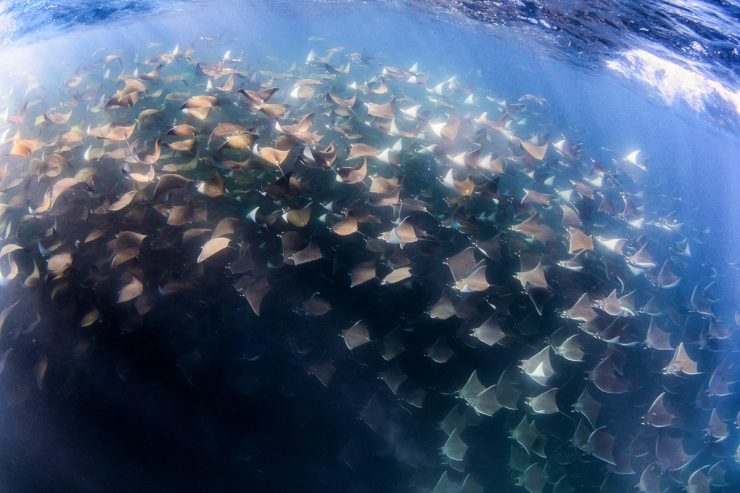
PROS: What I like about diving in Cabo San Lucas
Here are my top 5 reasons to scuba diving in Los Cabos
- Incredible Biodiversity and Wildlife: Cabo offers a rich marine ecosystem making it a haven for divers
- Suitable for Divers of All Levels: With a variety of dive sites catering to beginners and experienced divers alike.
- Easy Accessibility: Via SJD International Airport, ensuring convenient travel for divers.
- Proximity to Emergency Services: Safety is prioritized with Cabo’s proximity to EMS and hyperbaric chambers
- Year-Round Diving: With good diving conditions throughout the year, divers can enjoy fascinating marine life during any season.
CONS: Why you might think twice about diving in Cabo San Lucas (But you should anyway!)
There aren’t many reasons to avoid Cabo, but if I had to be nitpicky, these would be the reasons:
- Chilly Waters: Between May and July, water temperatures get colder, and visibility underwater may be reduced.
- Limited Coral Colors: While Cabo San Lucas possesses healthy coral reefs, they are naturally less vibrant in colour, which may disappoint divers seeking vibrant and colourful coral.
- It’s a popular place: Especially during spring break, Cabo can get crowded, leading to more tourist-centric activities in the area.
What you will learn from this Scuba diving guide:
After diving and travelling far and wide as a scuba diving instructor, I chose to settle in Mexico 10 years ago, and since then, Cabo San Lucas has become my diving haven.
In 2017, I established my own dive center here in Cabo San Lucas. Alongside my team, we’ve facilitated numerous dive trips and diving certifications, prioritising professionalism and safety, giving us a wealth of experience of the area.
In this comprehensive guide, I will give you essential insight into your scuba diving adventure in Cabo San Lucas :
- Ideal Times and Diving season: Discover the best times to explore the waters of Cabo San Lucas and when to come diving in Los Cabos.
The Diving Seasons of Cabo explained - Favorite Dive Sites: From soft coral reefs to canyons and wrecks, I will divulge our top picks for dive sites that promise unforgettable experiences, and the must-visit diving spots renowned for their beauty.
Cabo San Lucas Dive sites - Marine Life You’ll Encounter: Learn about the fascinating marine creatures and diving highlights awaiting you beneath the surface, from majestic whales to colorful schools of fish.
Highlights & Marine life sightings - Practical Diving Tips and Travel Information: I will talk about the valuable tips I have picked up along the way and essential travel information to ensure you a smooth time in Cabo.
Dive itinerary & Travel Tips
The dive sites of Cabo San Lucas
Before you arrive, you might be asking yourself, what are the best dive sites of Cabo San Lucas?
There is an impressive amount of dive sites you can reach directly from the town of Cabo. I have been to these sites thousands of times over the years in all sorts of conditions and know them like the back of my hand. We know every crack, every crevasse, and even some of the local wildlife who stay here all year round.
Where to dive in Cabo San Lucas ?
When diving in Cabo San Lucas, we have identified three main areas that we feel give the best demonstration of what Baja California has to offer while providing you with a safe experience:
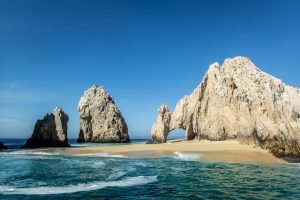
Dive sites of The Bay of Cabo San Lucas
Just a 10-minute boat ride from the Marina, Cabo San Lucas bay or Cabo San Lucas Marine Park offers five truly awesome dive sites.
From the iconic Lands End to Pelican Rock and Neptun’s Finger, divers of all levels find something extraordinary here.
Depths range from 15-130ft (5-40m), teeming with marine life and features include an iconic deep-sea canyon, sandfill, and a small shipwreck.
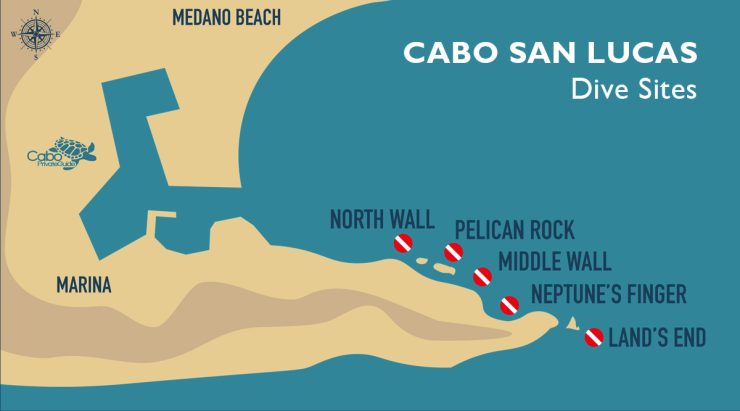
Pelican Rock Dive Site
- Depth: 15ft to120ft (5m to 40m)
- Level: Beginner to Advanced diver
- Highlight: Cownose Ray, school of Snapper, Angelfish, Porcupinefish, Damselfish, Butterflyfish, Seahorse, School of sardine…
Neptune’s Finger Dive Site
- Depth : 15ft to120ft (5m to 40m)
- Level : Advanced diver
- Highlight : Sand Falls & Deep Canyon, Mobula Rays, Guitar fishes, Tropical Reef fishes, School of sardine…
Land’s End (“The Arch”) Dive Site
- Depth : 30ft to75ft (10m to 25m)
- Level : Open water to Advanced diver
- Highlight : Sea lions, Lungberg shipwreck, Moray eels, Whitetip reef shark
North Wall Dive Site
- Depth : 15ft to 60ft (5m to 18m)
- Level : Beginner to Advanced diver
- Highlight : Cownose Ray, Mobula rays, Damselfish, Angelfish, Butterflyfish, Macro, Seahorse…
As a marine protected area, you are more likely to have encounters with rays, sea lions, and reef fish. Surface intervals may include thrilling whale sightings or a visit to the famous Arch of Cabo San Lucas. There is a reason I chose to have my dive shop here and not in other parts of Baja.
2 Tanks dive, Cabo San Lucas Bay
Dive sites of The Corridor of Los Cabos
A short 30-minute boat ride from the Cabo Marina, the dive sites in The Corridor of Los Cabos are situated within the remarkable waters of the Sea of Cortez.
With around 6 unique dive sites, notable ones include Blow Hole, Whale Head, Chileno Bay, Los Moros, Gavilanes and Santa Maria Bay.
While some are beginner-friendly, others like Blow Hole at 80ft/25m offer a more challenging dive.
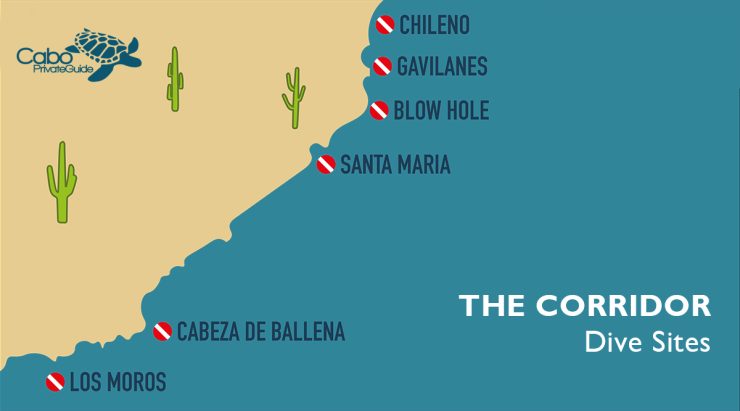
Whale Head Dive Site
- Depth : 30ft (10m)
- Level : Beginner to Advanced diver
- Highlight : Healthy Coral reef, Eagle rays, Needlefish, Angelfish, Porcupinefish, Damselfish, Butterflyfish…
Blow Hole Dive Site
- Depth : 40ft to 110ft (12m to 35m)
- Level : Advanced diver
- Highlight : White tip reef shark, Grouper, Snapper, Marine turtle…
Chileno Bay Dive Site
- Depth : 20ft to 60ft (8m to 18m)
- Level : Beginner to Advanced diver
- Highlight : Coral reef, schooling jacks, reef sharks, Tropical reef fishes, Macrolife …
Santa Maria Dive Site
- Depth : 30ft (10m)
- Level : Beginner to Advanced diver
- Highlight : Coral reef, Tropical reef fishes, Snapper, Macrolife…
Conditions may vary due to exposure to southern swells and north winds, making mornings dives ideal for exploration.
Nutrient-rich waters here attract species like eagle rays, white-tip reef sharks, and turtles, alongside vibrant tropical fish amidst healthy coral reefs. Keep watch for the majestic whales of Baja during surface intervals!
Gordo Banks Dive site
Located 29 miles (46.5km) offshore, Gordo Banks offers a thrilling dive after a 1.5-hour boat ride from Cabo San Lucas.
This site features a seamount, suitable for experienced divers with Advanced Certification. Dive depths range from 100-130ft (30m-40m), so consider getting a deep diver certification if you haven’t already.
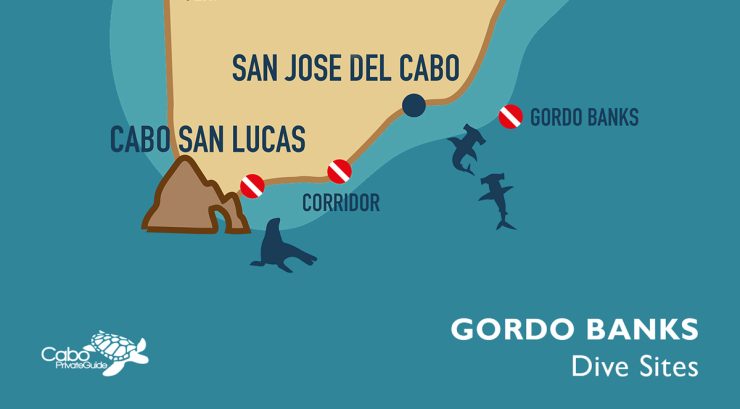
Gordo Banks Dive Site
- Depth : 30ft (10m)
- Level : Beginner to Advanced diver
- Highlight : Hammerhead Shark, Hound Sharks, Mobula Ray, Jacks Fish, Bonito, Yellowfin Tunas…
I also recommend a check-out dive beforehand due to potential challenges like strong currents and limited visibility. The best time to dive is September to December for better visibility.
Highlights include encounters with hammerhead and silky sharks, wahoo, and tuna. Keep an eye out for pelagic wildlife such as mobula rays, humpback whales, and if you’re lucky, dolphins and even orcas!
Why Scuba Diving in Cabo San Lucas?
Having travelled to dive sites worldwide, I can confidently say that Baja Sur ranks among the globe’s finest dive destinations, with Cabo San Lucas as not only a dive destination within it’s one right, but is a gateway to the whole peninsula.
Blessed with year-round sunshine and diverse dive conditions, the Baja peninsula offers a varied range of dive spots teeming with biodiversity.
Many people ask me, ‘Is Cabo San Lucas good for scuba diving? My answer may be biased, but I firmly believe Cabo is one of Mexico’s top scuba diving destinations.
Here are five reasons Cabo deserves a spot on your dive destination bucket list.
1. Incredible Wildlife and Biodiversity
Cabo is where the Pacific Ocean meets the Gulf of Mexico, also known as the Sea of Cortez. Why is this important you ask? Well, anytime two water bodies meet, there is often a convergence of ocean currents creating diverse marine habitats rich in nutrients.
This biodiversity supports a wide variety of species, offering divers an extraordinary array of experiences. Because of these currents, we have extremely healthy reef systems where you can spot a whole host of vibrant tropical fish, sealion, turtles, reef sharks, and other macro species.
Cabo also sits on one of the busiest ocean highways for migratory species. Baja is visited by large animals such as humpback and grey whales, iconic leaping mobula rays, and hammerhead sharks using sea mounts as rendezvous points after long journeys.
Cabo San Lucas Marine Life and Highlights
2. Easy Travel Diving Destination
Veteran divers understand the lengths one might go to in order to reach a dive site teeming with wildlife – often involving flights, buses, and ferries.
Nestled at the tip of the Baja peninsula next to the desert mountains of Sierra de la Laguna, Cabo San Lucas is surprisingly accessible.
Our international airport, SJD which is a mere 40 minutes away, links to major US and Canadian cities, Mexico City, and even Europe with direct or sometimes connecting flights.
Los Cabos SJD Airport
Carr. Transpeninsular Km 43.5, 23420 San José del Cabo, B.C.S., Mexique
+52 (624) 124 5500 / 124 5674
https://www.acsl.com.mx/en/
Accommodations and Hotels range from luxury villas to boutique hostels and affordable Airbnb’s, all within walking distance of our dive shop. Take a look at our dive and stay packages for a better idea of the lodging options available in Cabo San Lucas
English is widely spoken, ensuring smooth interactions when you visit one of the many restaurants to enjoy a quintessential Baja meal, such as taco de pescado (fish tacos).
3. A Safe Diving Destination
If you’re anything like me, prioritising safety during dives is paramount.
While incidents are exceptionally rare, it’s wise to be prepared for any eventuality. Ensuring safety begins with well-maintained dive equipment, which is readily available for rent at the trustworthy dive shops scattered around town. These dive shops have reliable, dedicated teams who prioritise equipment maintenance for their guests.
In the unlikely event of an emergency, rest assured that EMS services in Cabo are swift, arriving at dive locations within roughly 10 minutes.
Cabo San Lucas Hyperbaric Chamber
Hospital De Especialidades, Calle Adolfo López Mateos, Entre Leona Vicario Y Morelos
Cabo San Lucas, BCS 23410, Mexico
Phone : +52 624 143 3666
Emergency Phone : 1-800 700 2666 (Mexico only)
Additionally, Cabo has a hyperbaric recompression chamber conveniently located just 1.5 miles (2.5km) from the waterfront, reachable in a short 10-minute drive.
With such measures in place, divers can feel confident and secure exploring the depths of Cabo’s waters.
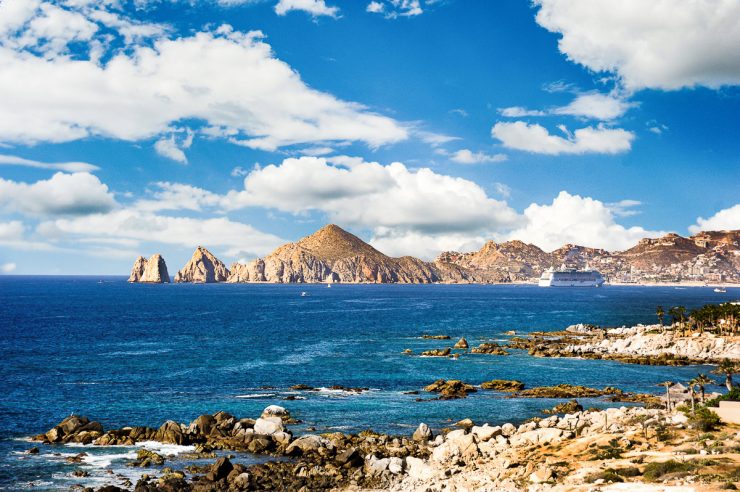
4. Great Diving Conditions & Weather
What I truly adore about Baja is its year-round diving experiences you can have here. While the climate on land stays dry and hot, the underwater seasons are distinct depending on the time of year.
The species you will come across in December are unlikely to be the same as in June. The unique range of migratory megafauna makes it a destination you can come to again and again and see something different.
It is the perfect place to escape those winter freezes and get some vitamin D and vitamin sea.
Best time to dive in Cabo San Lucas, quick answer:
- Diving in Cabo San Lucas offers year-round appeal, but for optimal conditions and unique marine encounters.
- August to November for the best visibility, reaching up to 65 feet (20 meters).
- December to April is Humpback Whale season.
- Encounter Hammerhead sharks year round.
- Experience the Mobula ray aggregation from April to July.
- Avoid May to July if cold water scares you off – but this is an incredible Ocean Safari season!
5. For All Types of Divers and Travellers
Novice divers can explore sheltered dive sites like Pelican Rock, where large schools of snapper and devil rays can be spotted at shallow depths.
Experienced divers can discover seamounts and deep oceanic canyons, plunging to depths of up to 100ft (30m) while searching for sharks. But make sure to pack your macro-lens. There are plenty of small critters like nudibranchs, frogfish, and seahorses.
Non-divers fear not! Our snorkeling is unmatched, We have abundant reefs and shallow bays teeming with life. Prefer to stay dry? Opt for horseback riding, off-road quad biking on sand dunes, or simply relaxing on our stunning beaches.
Cabo is also fantastic for group or family with children. As solo travelers or women divers you will have the opportunity to meet new, like-minded people and have fantastic experiences within our community atmosphere. There’s something for everyone here in CSL.
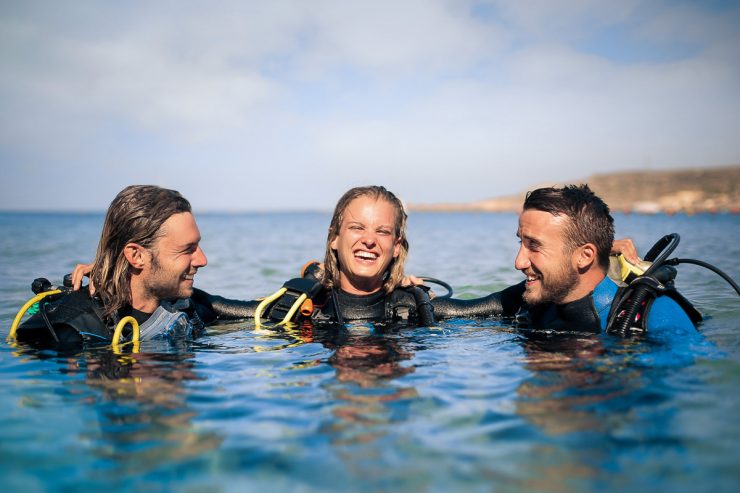
When to dive in Cabo San Lucas?
Once you’ve chosen Cabo as your diving destination, you may wonder, When is the best time to scuba dive in Cabo?
The short answer is always. Because Cabo offers great diving all year round, whenever the scuba blues hit you in the depths of winter, you can hop on a flight and dive all weekend.
Nevertheless, let’s break down each season to help you choose the perfect time for your Mexican scuba adventure:
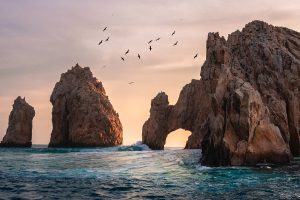
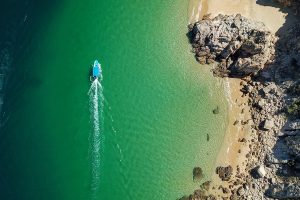
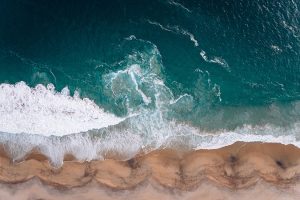
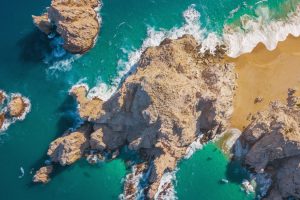
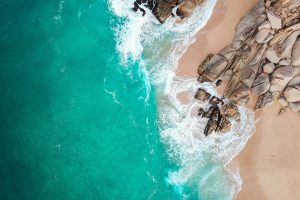
Weather in Cabo San Lucas
With diverse marine life and favourable conditions, Cabo is a must-visit for all underwater explorers, offering something regardless of the season.
If you can, I recommend experiencing Cabo’s diverse marine climate across all the seasons.
The real magic happens from November to mid-December when the water is still warm, hurricane swells have passed and air temperatures range from 77°F to 86°F (25°C to 30°C).
June to October brings the hottest air temperatures, ranging from 88°F to 96°F (31°C to 38°C).
However, keep in mind that the hurricane season, starting from the end of May to beginning of October poses a risk of hurricanes and tropical storms. September and October can bear the brunt and carry a lot of swell.
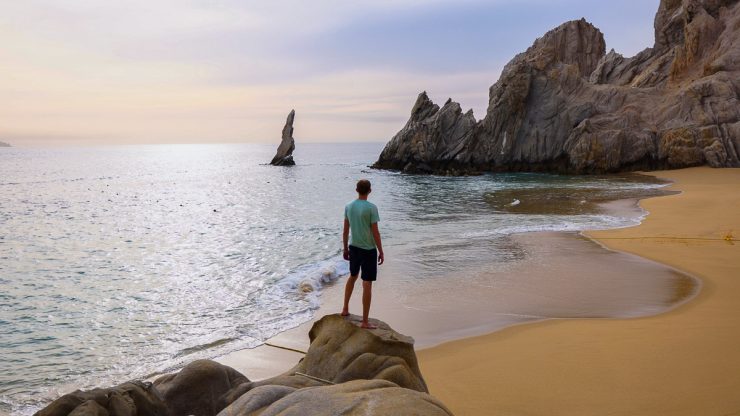
Water Visibility in Cabo San Lucas
For exceptional water visibility, plan your visit between August and November, with clarity up to 100ft (30m), contrasting with lows of 16ft – 30ft (5m – 10m) in sporadic days in May-July.
Sea Visibility in Cabo San Lucas
| Months | Visibility in Feet | Visibility in Meters |
|---|---|---|
| August to November | 40 to 80 feet | 12 to 20 meters |
| December to April | 25 to 50 feet | 8 to 15 meters |
| May to July | 20 to 40 feet | 6 to 12 meters |
Sea temperature in Cabo San Lucas
Although Cabo maintains warm temperatures year-round, water temperatures fluctuate seasonally.
Late summer through early winter brings toasty waters, particularly from October to December, reaching up to 86°F (30°C).
On the other hand, spring and early summer offer more exhilarating temperatures ranging from 59°F to 73°F (15°C to 23°C).
Depending on your tolerance, you may opt for a semi-dry suit for the more refreshing dips. However, these temperature variations ensure thrilling dives throughout the year in Cabo.
| January to July | 70°F to 61°F | 21°C to 16°C |
| August to October | 73°F to 82°F | 23°C to 28°C |
| November to December | 78°F to 70°C | 25.5°C – 21°C |
Spring diving in Cabo San Lucas (March, April, May)
Spring diving in Cabo has a great vibe. It’s one of the busiest times of year in town due to it coinciding with Spring break giving it a real buzz.
You are still able to spot whales and whale sharks as they are with us until April but the underwater world becomes a bit more challenging to navigate during this time as we move into March, one of the windiest months of the year, affecting diving conditions. Great time for Macro diving!
- Water Temperature: 68°F (20°C) Avg.
- Water Visibility: 32 feet (10 meters) Avg.
- Air Temperature: 79°F (26°C) Avg.
- Rainfall: None
However, as air temperatures gradually pick up from 77°F to 82°F (about 25°C to 28°C), divers can still enjoy the vibrant marine life Cabo has to offer with the coral reefs abundant all year round.
Due to windy conditions, the water temperature is relatively cool during spring, ranging from about 72°F(22°C) in March to 59°F(15°C) in May, making it a refreshing and invigorating diving experience.
Summer diving in Cabo San Lucas (Jun, Jul, Aug)
What’s look like diving in Summer in Cabo San Lucas ? You may now be thinking it’s a no-brainer and that you will come to Cabo in the winter when the water is warm. Well, let me tell you why you may be making a big mistake.
- Water Temperature: 65°F (18°C) Avg.
- Water Visibility: 26 feet (8 meters) Avg.
- Air Temperature: 86°F (30°C) Avg.
- Rainfall: Moderate
Although the water is colder in summer, getting as low as 59°F/15°C on a particularly cold year, it’s one of my favourite diving season : The season of the Mobula ray ! This is the time of year we are visited by thousands of Munk’s devil ray aka the pygmy devil ray.
From June to October, Cabo experiences its hottest months, with temperatures soaring up to 93°F/34°C in August and September, offering a quick warm-up post-dive.
Fortunately, this period largely avoids the hurricaine season, which typically picks up at the end of August.
Water visibility in Cabo also varies significantly from week to week from 30ft to 60ft in a typical summer.
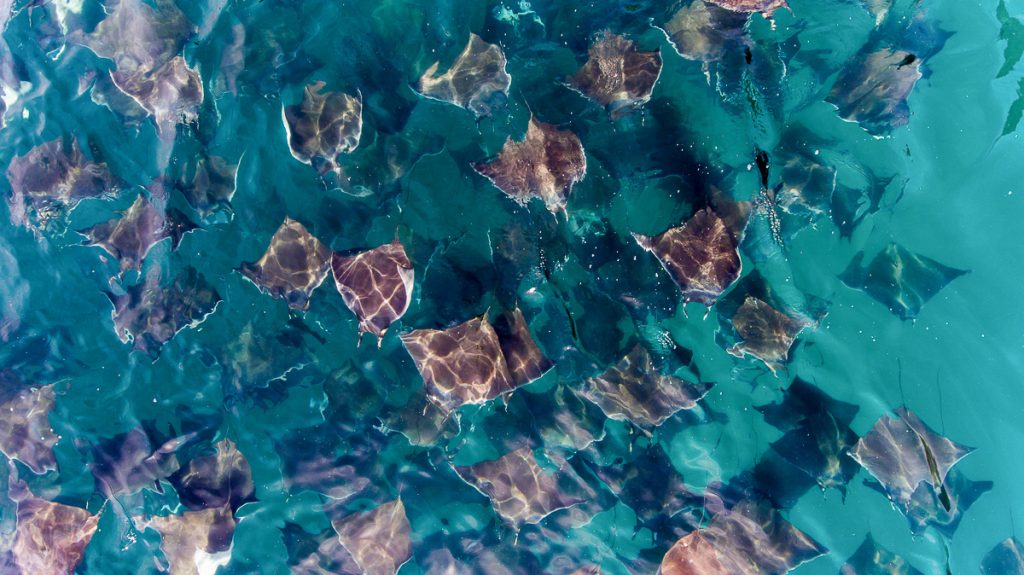
Autumn Diving in Cabo San Lucas (Sept, Oct, Nov)
In September, Gordo Bank offers excellent visibility for spotting hammerhead sharks and getting away from the coastal swell.
Day trip to La Paz offers some great wreck diving options, while Cerralvo Island in La Ventana are full of amazing reeflife and pelagic encounters away from the coastal swell in Cabo.
While diving in autumn in Cabo, by November, sea lions return to Land’s End for some hilarious interactions and the bait baills start to spawn making or some spectacular local diving.
- Water Temperature: 82°F (27°C) Avg.
- Water Visibility: 50 feet (15 meters) Avg.
- Air Temperature: 86°F (30°C) Avg.
- Rainfall: Moderate
Balmy temperatures of 90-95°F (32-35°C) come in from September to October, with water temperatures ranging from 79-90°F (26-32°C).
As November arrives, temperatures cool slightly, with water temperatures dropping to around 77°F (25°C).
The cooling means the fish return to shallow waters in abundance, visibility and diving remain excellent throughout fall, ensuring spectacular marine sightings and unforgettable diving experiences in Cabo San Lucas.
Winter Diving in Cabo San Lucas (Dec, Jan, Feb)
Winter diving in Cabo brings the start of whale season, with humpback whales migrating to breed and calve in the warm waters of Baja California Sur.
Winter is a slightly cooler season, but filled with remarkable underwater encounters.
Lucky divers may encounter humpback whale breaching and playing on surface intervals and a lucky handful have had amazing encounters underwater at Gordo Banks. Meanwhile, sea lions at Land’s End entertain divers with their curious and playful antics.
- Water Temperature (Avg.): 72°F (22°C)
- Water Visibility (Avg.): 32 feet (10 meters)
- Air Temperature (Avg.): 77°F (25°C)
- Rainfall (Avg.): Almost None
Air temperatures cool to around 77°F (25°C) by January and February, with water temperatures starting at approximately 73°F (23°C) in December and dropping to roughly 68°F (20°C) by February.
Cabo San Lucas Marine Life and Highlights
Now time for my favorite topic and likely the major reason you scuba dive in the first place.
We have touched on some of the major sights here in Cabo, but let’s answer the question I am sure you are asking. What will I see while scuba diving in Cabo San Lucas? Well, the answer is a lot, shall we take a closer look?
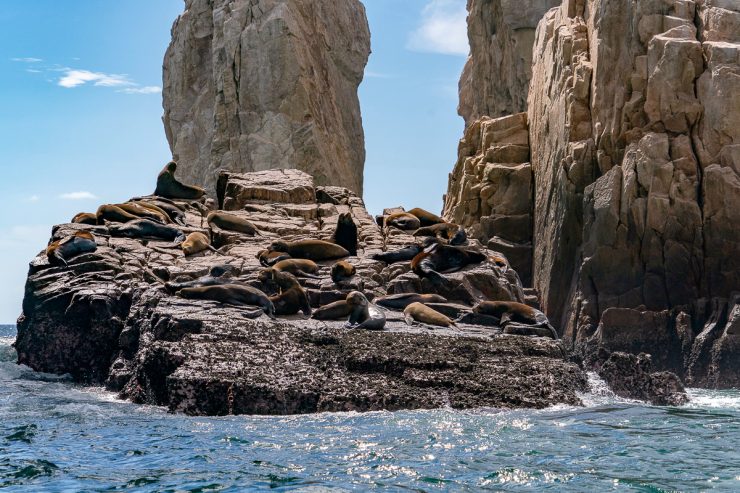
California Sea lion
We are absolutely hooked on snorkeling and diving with sea lions – it’s like being underwater with aquatic puppies!
Their playful antics and curiosity make every underwater encounter delightful. Between November and April, we’re treated to daily sightings at Lands End in the Cabo San Lucas Marine Park.
How to see Sea lions:
- Season: November to April
- Dive Sites: Lands End (Cabo San Lucas Marine Park)
- Required experience: For all divers.
- Spotting Tips: Sea lion are curious, let them come to you.
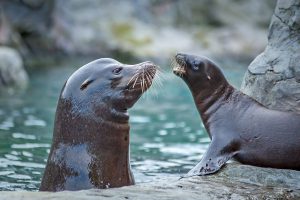
These impressive water dogs make long journeys from more northern regions, sometimes as far as British Columbia and Washington State. During the chillier months, they retreat down to Baja for warmer waters and shelter their pups.
Their curious and social personalities ensure each encounter is packed with excitement for those of you who come down scuba diving in winter and spring.
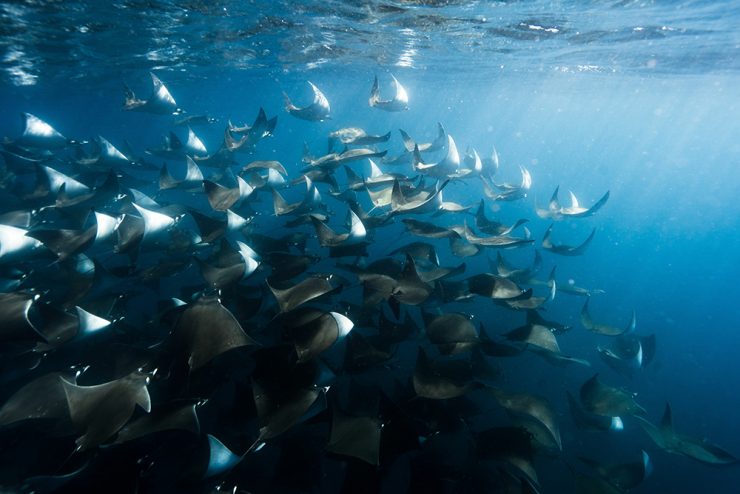
Mobula Rays
Let’s talk about one of Cabo’s most astounding biological events – the Mobula ray aggregation!
Just a short 10-minute boat ride from Cabo San Lucas Marina, you’ll be surrounded by swarms of these captivating creatures in the Sea of Cortez.
Despite being smaller than Manta rays, Munk’s Pygmy Devil Rays (Mobula Munkiana) are equally as impressive. Witnessing this phenomenon firsthand is a treat, as the rays display unique behaviors, including ‘popping out’ from the surface reaching up to 6ft high, and belly-flopping down with loud slapping noises.
How to see Mobula Rays:
- Season: June to July
- Dive Sites: Neptune’s Finger, Lands End, Blow Hole, Whale Head.
- Required experience: For all divers.
- Spotting Tips: Best seighting while snorkeling. Avoid sudden movements so as not to frighten them.
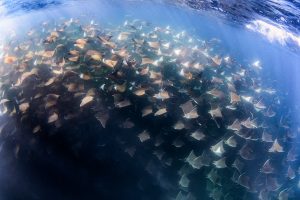
The Mobula Munkiana is a vulnerable species. They gather in their tens of thousands around Cabo San Lucas, creating breathtaking displays as they leap out of the water in synchronised movements for reasons still unknown to us.
Witnessing the Mobula aggregation is an unforgettable experience making braving the colder water worth it for a chance to swim in and amongst this spectacle of nature.
You can see Mobula rays on an ocean safari or snorkeling tour between June and July for an up-close encounter with these flying creatures and see this mesmerizing spectacle.
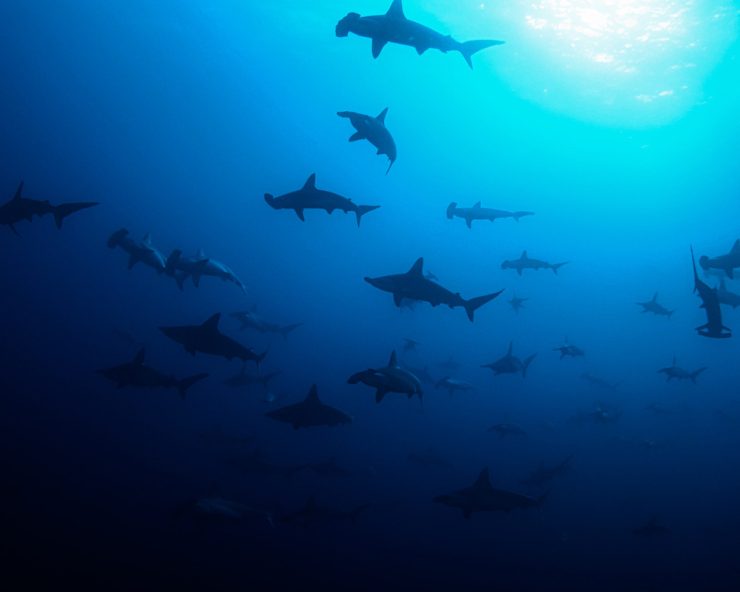
Hammerhead Sharks
For those of you attracted by apex predators, meeting hammerhead sharks is often the holy grail. Fortunately, in Los Cabos, we have access to an incredible aggregation of these migratory species at Gordo Banks dive site.
The hammerhead sharks use the sea mount for a behavior called “refuging” where hammerhead sharks gather in large numbers during the day around the seamounts to seek shelter from currents and socialize.
How to see Hammerhead Sharks
- Season: All Year (Best September to December).
- Dive Sites: Gordo Banks
- Required experience: Experienced divers (min. Advanced Open Diver Certification)
- Spotting Tips: stay below the sharks, do not swim directly towards the school of sharks as this may frighten them.
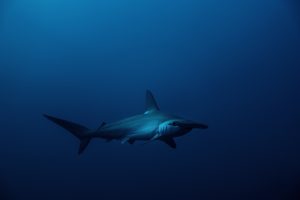
While many hammerhead species have vanished from Mexico’s Pacific Coast due to fishing, the scalloped hammerhead still thrives in our waters.
Divers can swim alongside schooling hammerheads at this offshore site, where you can surface with unforgettable memories. While sightings aren’t guaranteed due to factors like water clarity and currents, the best time for encounters is from September to December.
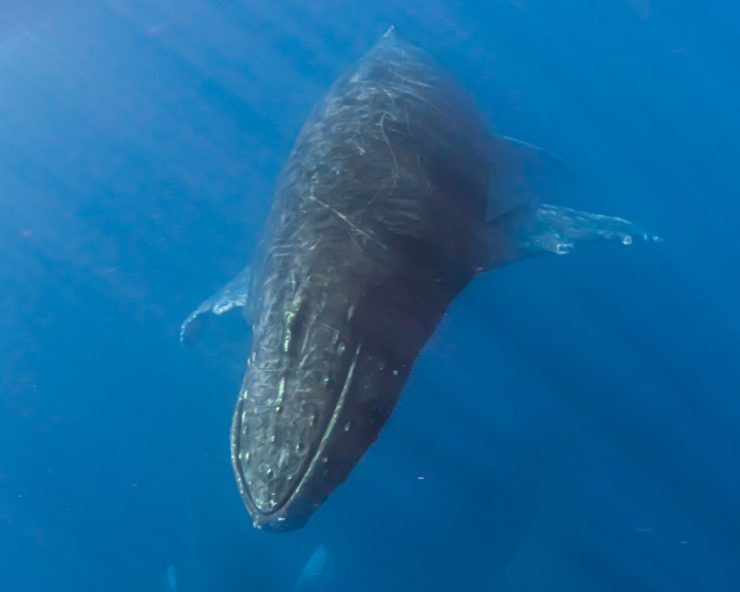
Humpback Whales
The Humpback Whales, can reach 45-55ft (14-17m) in length and weigh up to 35 metric tons, making them some of the largest on the planet.
They put on a display of breaching and tail-slapping as they pass by Cabo. You can see them from boat trips and diving surface intervals with sightings being virtually guaranteed during peak season.
Cabo is renowned as one of the world’s premier destinations for whale watching.
How to see Humpback Whales:
- Season: December to April
- Dive Sites: The Bay of Cabo San Lucas, The Corridor.
- Required experience: For all divers
- Spotting Tips: In almost all dives between surface interval from the dive boat.
Their haunting whale songs can sometimes be heard too. These symphonies are often performed by the males, and we aren’t 100% sure why, but guesses are that it has to do with the mating season! You won’t want to miss the chance to witness these magnificent creatures in their natural habitat, trust me!
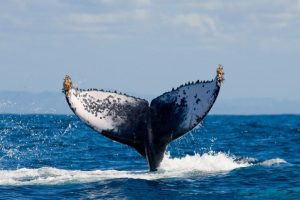
Whale watching season in Cabo San Lucas
From December 15 to April 15, the official whale season attracts visitors eager to witness the majestic humpback whales and other species as they migrate along the Mexican Pacific coast.
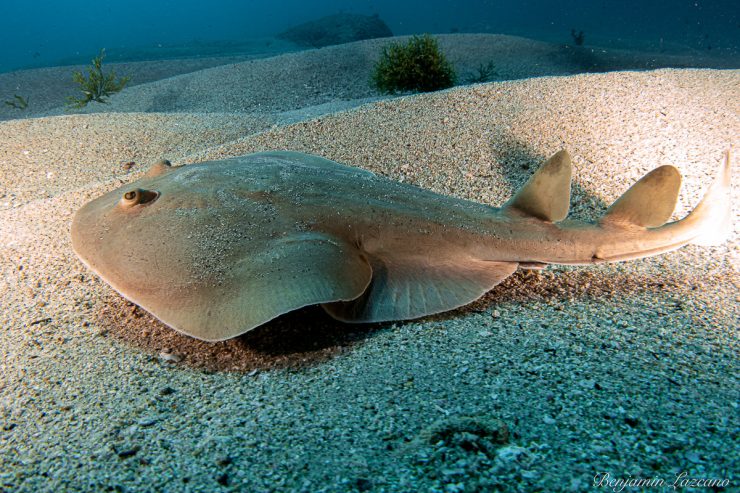
Sharks and Rays
While Mobula rays and hammerheads steal the spotlight, Cabo has a diverse array of bucket-list species in its waters and show of a large variety of Elasmobranchii.
From the graceful Spotted eagle rays and majestic Cownose rays to the gentle giants like whale sharks, and even the notorious Bull sharks, there’s no shortage of thrilling encounters. But that’s not it —divers sometimes come across Manta Rays and Torpedo rays, as well as White Tip Reef Sharks and Guitar Sharks.
A dive in Baja California offers the chance to check off numerous species from your “must-see” list, making it an awesome place to dive.

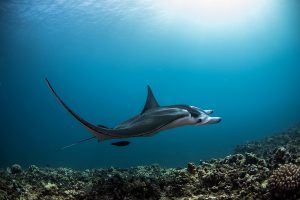
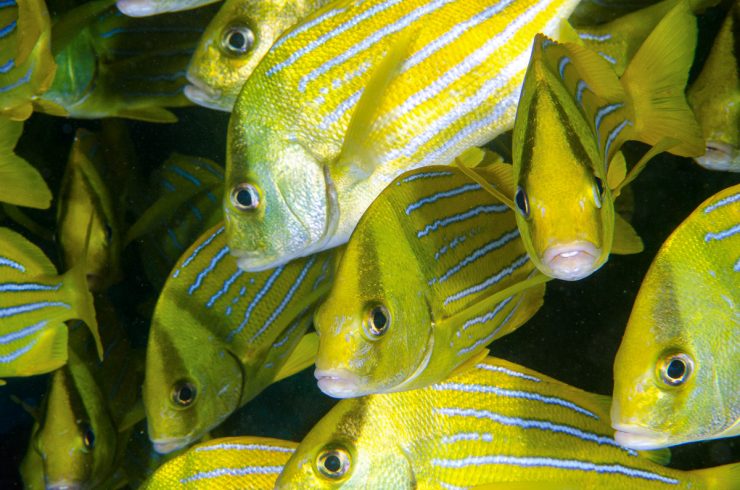
Tropical reef fish
In our stunning waters here in Cabo, vibrant communities of Pacific tropical reef fish thrive, creating a display of colors and shapes everywhere you look.
The Baja California coastline is home to more than 600 species of fish. Diving the waters of Cabo San Lucas, you will be submerged by a wide variety of Pacific reef fish such as (non-exhaustive list):
- Angelfish
- Pufferfish
- Porcupinefish
- Trumpet fish
- Damselfish
- Porkfish
- Tangs
- Butterflyfish
Marine Invertebrates
The dive sites here in Baja offer a rich tapestry of marine life, meaning you always see something awesome regardless of whether you are diving or snorkeling.
From elusive Octopus to Spiny Lobster hidden among the reef’s nooks and crannies.
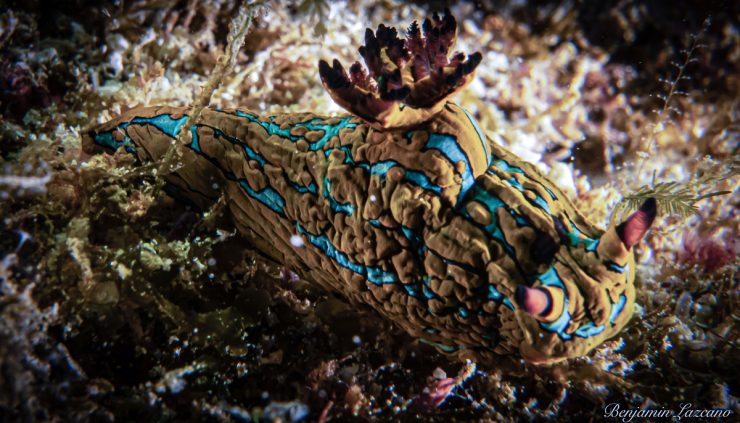
Macrolife
The rich biodiversity of Cabo San Lucas offers ample opportunities for stunning macro shots, catering to photographers of all levels.
Whether you’re a pro or a beginner, you’re sure to find something small worth taking footage of! Los Cabos is a prime spot for macro photography enthusiasts because of our diverse marine life like :
- Nudibranchs
- Giant seahorses
- Frogfish
- Blenny Fish
- Sea hare

Marine Turtles
Turtles can be seen on the reef and during the spring nesting and hatching on the beach. Here you can witness the adorable sight of baby turtles being released into the ocean, thanks to initiatives like The Eastern Pacific Leatherback Turtle Conservation Network.
Baja California is a haven for sea turtle enthusiasts, as we host five out of seven species:
- Loggerhead
- Hawksbill
- Olive Ridley
- Leatherback
- Black Turtles
Turtles are vital for coral ecosystems, keeping reefs healthy by eating algae that can stifle coral growth, ensuring thriving reefs. Unfortunately, these animals are extremely susceptible to decline as coastal development leads to the loss of nesting and feeding sites, disrupting their natural habitats.
Deep Canyon and Sand Falls
As an experienced diver, I’m drawn to the depths of Neptune’s Finger where I can descend up to 100ft/30m to witness the unique geological features that result in a continuous underwater cascade of sand, known as a submarine sand fall.
It’s quite a unique diving experience as there are only a handful of places on the globe where you can see these cascades, like a slow-motion waterfall into the abyss
The “Lundenberg” Shipwreck
Down at the Land’s End dive spot, after you have played with the sea lions, you’ll stumble upon the remains of the cargo ship Lundenberg, lost to the depths back in ’54.
It’s a solid reminder of how the sea can be both a giver and a taker. Sadly, it’s too small and falling apart to explore inside, but that doesn’t stop it from being a great wreck site to explore!
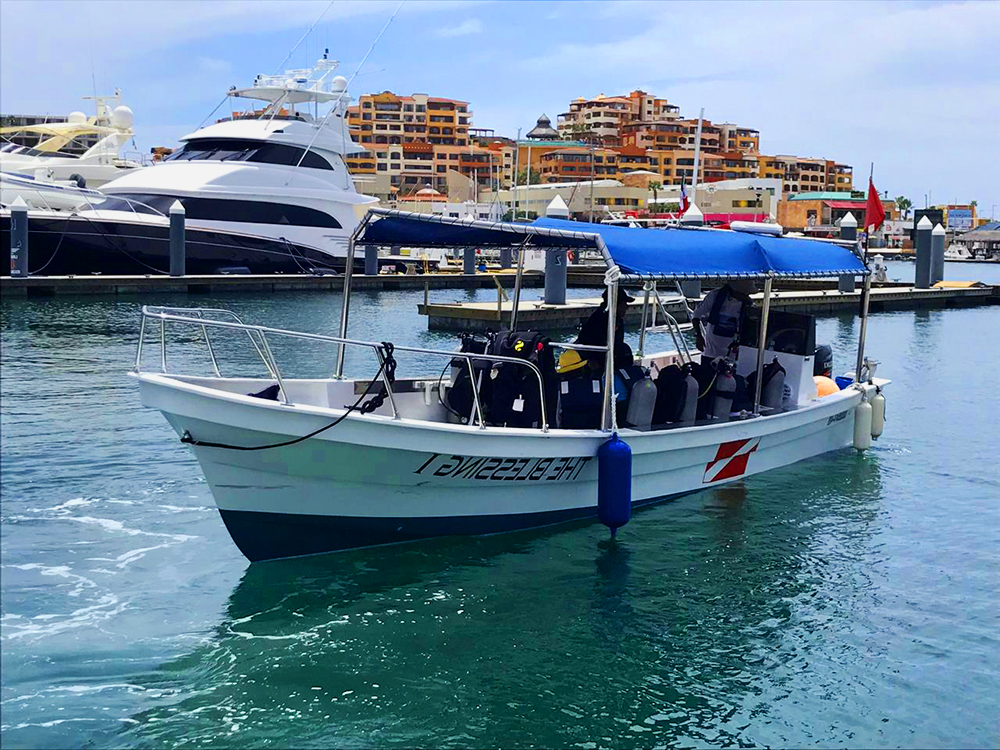
How to dive in Cabo San Lucas & Recommended itinerary.
Whether you have been in the dive game a while or are coming here to dip your toes into the world of scuba, our recommended itinerary ensures you will experience the best parts of Cabo’s underwater world. So, grab your gear, and let’s get into how to dive in Cabo San Lucas.
Daily Boat diving
All dive trips from Cabo San Lucas depart from well-equipped dive boats, typically either a Panga boat (a traditional, open-deck Mexican fishing boat) or a larger vessel.
Dive sites are conveniently close to the main marina, with the Cabo San Lucas Marine Park just 10 minutes away and The Corridor reachable within 30 minutes.
For an exceptional deep dive at Gordo Banks, approximately 1 hour away, it’s worth the trip if you’re qualified and confident.
Departures are from Cabo San Lucas Marina, with morning and/or afternoon tours available.
If you’re super keen and short on time, you could even squeeze in three dives in a single morning so you can make that business call in the afternoon.
Private Boat and Diving Yachts
Experience the height of luxury and flexibility with our private dive yacht or boat charters here in Los Cabos. With a wide selection of vessels available, including yachts and catamarans, tailored to your preferences, you can indulge in a truly personalized diving adventure.
You can easily avoid the crowds and design your own dive schedule, choosing exactly which dive sites you want to explore!
Our private dive charters at Cabo Private Guide offer more than just diving; you can also enjoy reef snorkeling, swimming with mobula rays, whale watching, or even a combination of activities. Ask us at info@caboprivateguide.com to customize your ocean experience.
Diving day trips from Cabo San Lucas
Staying in Cabo opens doors to nearby dive destinations easily accessible through organized day trips.
Joining these trips, normally managed by your dive center, offers you opportunities to explore places like La Paz, Cabo Pulmo, and Cerralvo Island, each with distinct marine experiences.
Departing from Cabo San Lucas in the early morning, these day excursions include two-tank dives and a leisurely lunch before returning by late afternoon.
See our “Nearby diving locations” section for more info.
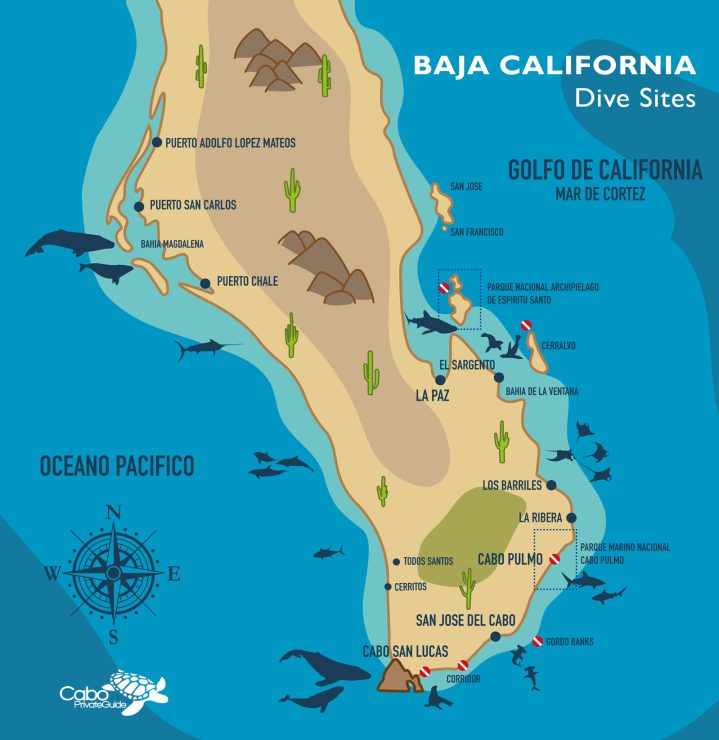
Recommended dive travel Itinerary
Diving in Los Cabos is highly seasonal, with wildlife and water temperatures varying throughout the year.
Check the season and wildlife calendar before planning your trip for optimal diving conditions and the best chance of seeing the species you are most interested in.
For a well-rounded experience, dedicate 7 to 10 days to exploring Cabo’s underwater wonders.
Here’s a sample diving itinerary to make the most of your time:
- Days 1-3: The Cabo San Lucas Marine Park and The Corridor, where you’ll find over 15 dive spots waiting to be explored. These nearby sites offer the perfect introduction to the diverse marine life of the Sea of Cortez, easing you in gently.
- Day 4: Dive deep at Gordo Banks for an exciting encounter with hammerhead sharks and witness the underwater marine sandfall, a unique geological phenomenon that will leave you speechless, partly because you can’t talk underwater.
- Day 5: Take a break from diving to let your body rest and recharge. Use this downtime to explore the beauty of Cabo on land, whether it’s horseback riding, hiking to one of two look-out poinits, or simply relaxing and soaking up the sun on the beach.
- Day 6: Time for a diving day to Cabo Pulmo National Park, home to thriving coral reefs that are teeming with snappers, majestic groupers, and maybe even bull sharks.
- Day 7: Head to La Paz for a once-in-a-lifetime opportunity to swim alongside the gentle giants – the whale sharks. Round off your Cabo scuba adventure with a late morning of whale watching or maybe see the flying rays on a sea safari.
Need more ideas for your dive itinerary or where to stay in Cabo?
Have a look at our seasonal diving packages around Baja and our dive and stay deals featuring handpicked hotels in Cabo.
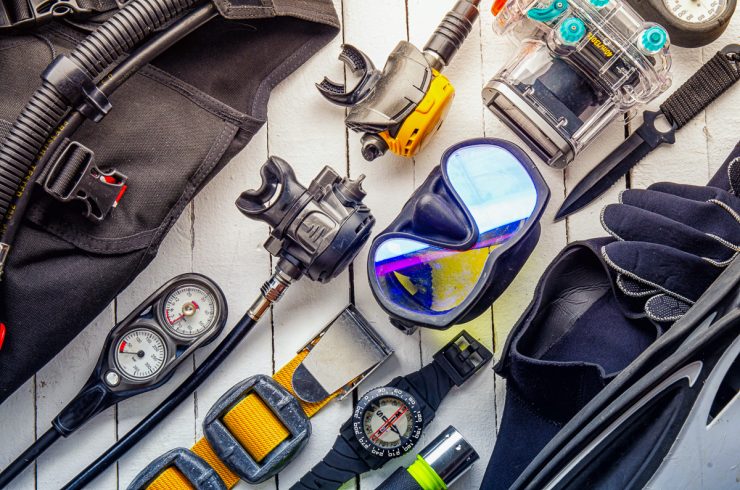
Recommended gear and wetsuit for diving in Cabo San Lucas
Unfortunately, here in Los Cabos, you won’t find dedicated dive supply shops for purchasing equipment, but luckily there are plenty of places to rent gear from.
If you don’t want to rent of course you can bring your own gear too. Just make sure to plan accordingly to ensure you have everything you need, for your underwater trip.
Diving Wetsuits
Unless you’re made of steel, a wetsuit is essential for comfort during dives, considering the varying water temperatures.
Some divers may brave 82°F (28°C) waters with just a rashie, while others prefer the warmth of a 3mm.
Do you need a wetsuit to dive in Cabo San Lucas?
As a general guide, we recommend a 5mm to 7mm long wetsuit for the Dec to July season, and a 3mm to 5mm for August to November.
I personally go diving with a 5 mm long wetsuit and a Thermal top and a dive hood when the water is the coldest. Remember, thicker wetsuits increase your buoyancy, requiring more weights to stay down, which is most crucial during safety stops!
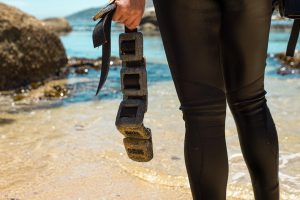
Diving Fins
When it comes to fins, we highly recommend bringing your own. There’s nothing worse than diving with ill-fitting fins that cause discomfort, rubbing, and blisters.
This is especially crucial for dives at Gordo Bank, where strong currents require fins that can handle some tougher conditions.
The type of fin you choose is personal preference, but I always opt for some slightly heavier open-heel fins. Those fins allow for adjustments if you’re wearing booties and offer a more comfortable fit overall.
BCD and Regulator
Most dive centers in Cabo San Lucas provide excellent diving gear for rent, ensuring a safe and enjoyable experience. Additionally, there’s one specialized shop in town equipped with spare parts and skilled technicians capable of fixing or servicing diving equipment.
If the idea of sharing a mouthpiece on a rented regulator doesn’t sit well with you, consider bringing your own. Brands like ScubaPro and Aqualung offer reusable mouthpiece clamps compatible with only their gear, but a clever alternative is to pack reusable zip ties to minimize single-use plastic waste.
Dive Computers, SMBs, and Signal Devices
Prioritizing safety is crucial whenever you’re diving. That’s why it’s wise to have additional safety gear such as a dive computer, surface marker buoyancy (SMB), and a signaling device on hand.
You can easily find SMBs, whistles, and signaling devices online at affordable prices. Most dive centers will also offer dive computers for rent upon request.
With these essentials readily available, you can enjoy your dives with peace of mind, knowing you’re well-prepared for any situation that may arise.
Dive Lights and Underwater Cameras
Carrying a torch (also known as a dive light) while exploring can significantly enhance your diving experience. I like to use it to illuminate hidden species among cracks and crevices like spiny lobsters, nudibranchs, and octopuses.
Dive lights are also an extremely useful tool for communicating with your buddy and dive guide if the visibility is less than perfect.
GoPros and other action cameras also don’t do too great after 32-49ft (10-15m) due to low light and colour absorption so bringing a torch will help increase the quality of your underwater footage and help showcase what it’s really like down there.
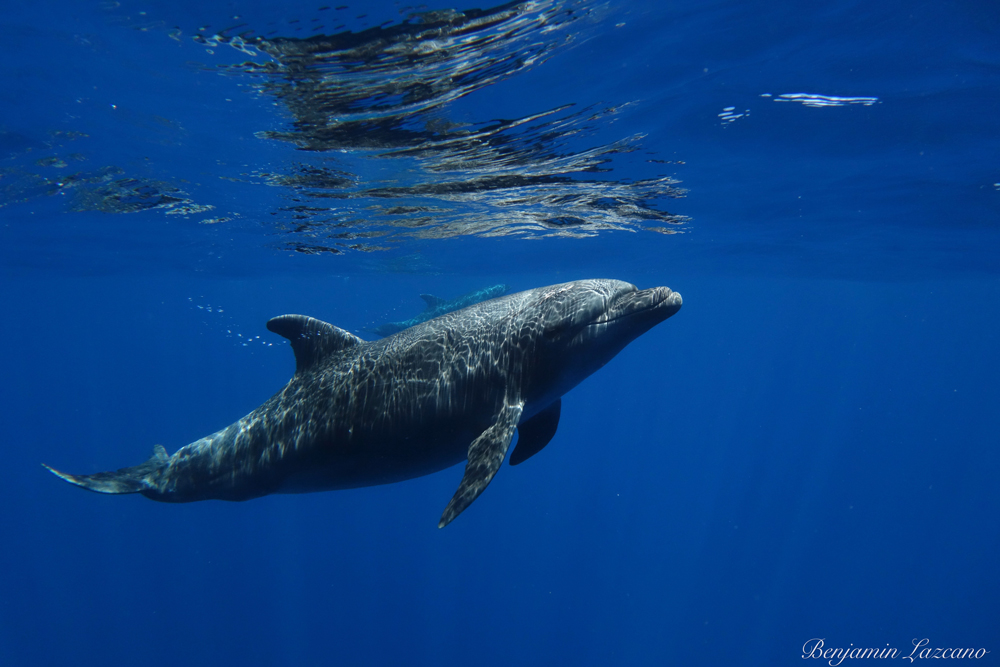
How much does it cost to scuba dive in Cabo San Lucas?
Though not the cheapest compared to other destinations, encounters with sharks, whales, and sea lions, alongside a top-notch service, justify the investment.
Diving in Cabo offers incredible value for unforgettable experiences.
Living costs in pesos are relatively affordable, including dining and accommodation. A double tank dive with equipment costs $120 to $150 USD, while a full PADI Open Water Course (covering theory, pool sessions, and 4 dives) ranges from $550 to $700 USD.
Investing in diving insurance, like DAN (Divers Alert Network) or Dive Assure, is also a smart idea and ensures coverage for diving-related emergencies, with yearly plans starting at $40. While some standard travel insurance policies offer coverage up to a certain depth, it’s essential to check the details as most only cover up to shallow depths.
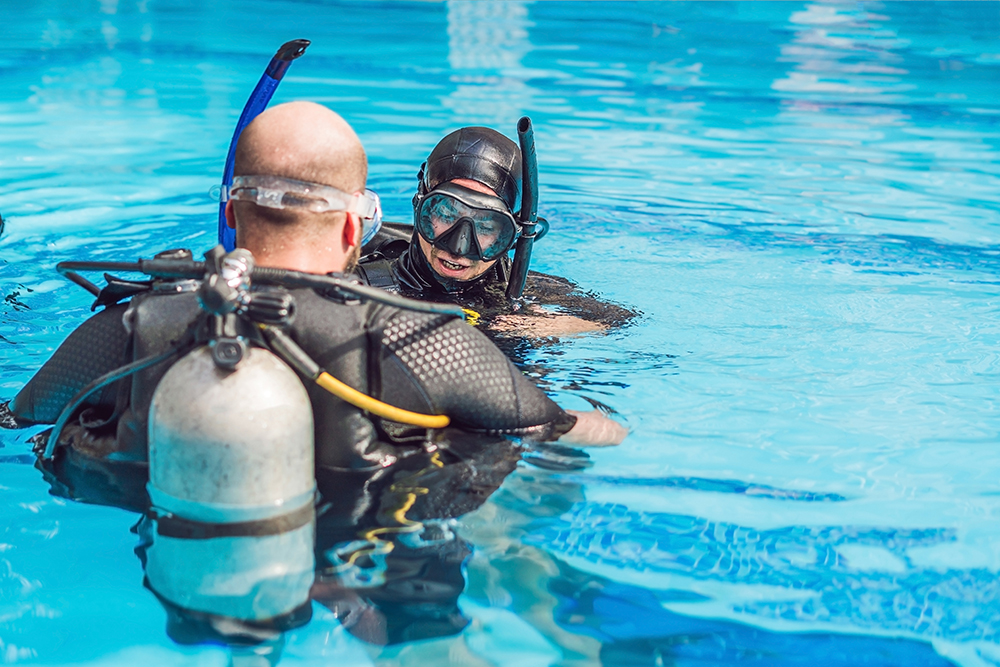
Scuba diving courses in Cabo San Lucas
If you’re new to diving, you might be wondering: “Do I need certification to scuba dive in Mexico?”
On the other hand, if you’re already certified, you might be curious about the certifications available to you here in Los Cabos.
Before diving into the details of each level, let’s cover the basics. Depending on the dive shop you choose, you’ll train with a specific certification body, each with its own unique approach.
For clarity, we’ll focus on the widely recognized PADI organisation, which we use at our dive shop.
Before committing to a full scuba course, consider a discovery scuba diving (DSD) experience. Though not an official certification, it offers invaluable practical experience so you know how you will be in the water while glued to a dedicated instructor. After this, you’ll likely be eager for more, ready to start your PADI Open Water Diver course, the first certification of PADI scuba diving.
Try scuba diving in Cabo San Lucas
Kids Scuba Diving Vacation Camp
Learning how to dive & beginner courses
Cabo San Lucas offers an ideal setting to begin your diving journey, whether earning your open water certification or partaking in the discovery scuba diving excursion.
With our extensive experience in Baja’s popular dive scene, we prioritize producing confident, competent divers in safe conditions year-round.
Abundant underwater species and sheltered spots ensure a fabulous learning experience, allowing for skill refinement and confidence building.
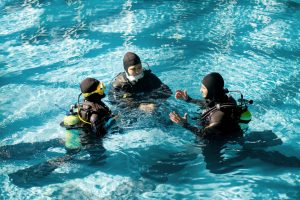
Our commitment to high standards and safety guarantees a fulfilling, secure dive for beginners. The PADI Open Water Diver certification enables unsupervised dives with a buddy up to 59ft (18m) worldwide, although regular skill refreshers are essential, especially after extended breaks. We ALWAYS provide a guide as a matter of safety and to optimize your dive experience.
PADI Opend water diver certification
Advanced and Rescue Courses
After completing the Open Water course, the Advanced course is the natural next step. This program expands on foundational skills, introducing you to new dive environments and activities. Through five adventure dives you’ll gain valuable experience and confidence underwater.
Taking the Advanced Open Water course means you will be qualified to dive deeper, up to 30m deep, meaning you could check out the local shipwreck and the submarine sandfall at Gordo Bank Pinnacle, where you might encounter schooling hammerheads.
We also offer the PADI Rescue diving course, which instructors and divers, including myself, find particularly rewarding. Despite the serious topic of health and safety, this course builds confidence and capability like no other.
In the rescue course, you’ll learn to prevent and manage dive emergencies, honing essential rescue techniques and leadership skills. Through classroom sessions, confined water exercises, and open water scenarios, you’ll gain a strong sense of responsibility and know-how, preparing you to handle emergencies with confidence both in and out of the water.
PADI Advanced Open Water Certification
PADI Rescue Diving certification
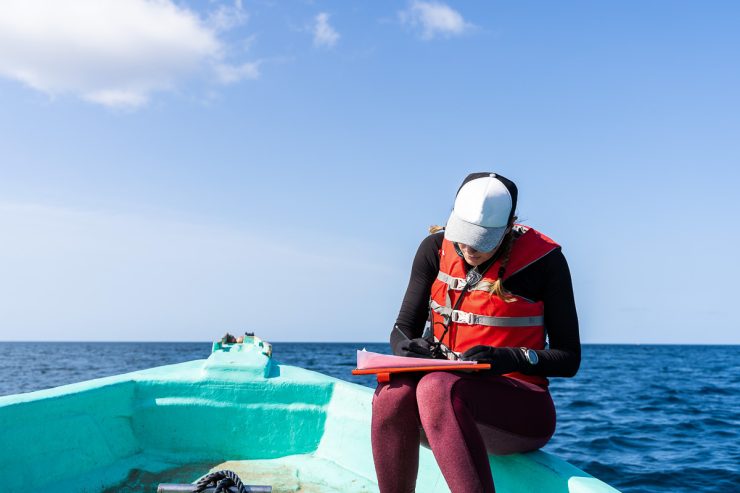
Marine conservation courses
You can gain a whole host of specialty courses with PADI. Some allow you to dive with Nitrox and others mean you can go up to 130ft down (40m). We offer all these courses at Cabo Private Guide, but the ones that are close to our hearts, as a 5-star PADI ECO Dive Centre, are the Marine conservation courses.
Now is more important than ever to ensure our oceans are protected. It all starts with us.
With such diverse marine life in Baja, we felt it was our responsibility to offer conservation education. Our waters are teeming with unique life that requires protection, and we’re privileged to spread awareness.
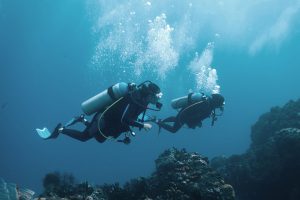
At Cabo Private Guide, we provide PADI Shark Conservation Specialist, PADI AWARE Diver, Coral Conservation course, Peak Performance Buoyancy and Dive Against Debris courses; the latter empowers you to make an immediate impact by removing discarded fishing nets and waste from our seas.
Beyond official PADI courses, you can join us on the front line through The Mobula Conservation Project, Shark Research Mexico or Pelagios Kakunja. Your sightings data directly contributes to studies of species protection.
PADI Marine Conservation courses
Pro and Divemaster courses
Feeling reluctant about wrapping up your diving adventure in Cabo? Of course you are!
Cabo San Lucas offers top-notch diving, high safety standards, and an affordable, sun-filled lifestyle year-round. So why rush home? Extend your stay and enroll in a Divemaster internship in Cabo San Lucas.
This program provides advanced diving techniques, leadership skills, and hands-on experience supervising divers. You’ll also understand the operations of a dive shop and can also enhance your course with a marine conservation program.
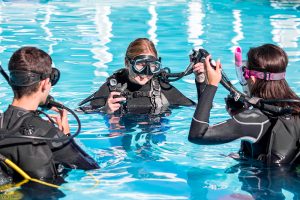
Our flexible dive master internships range from 6 weeks to 12 weeks, allowing us to impart our expertise and rack up plenty of dives together. After certification, you’ll be equipped to work in the dive industry, sharing your love for diving while exploring the underwater world professionally. Sounds pretty awesome right?
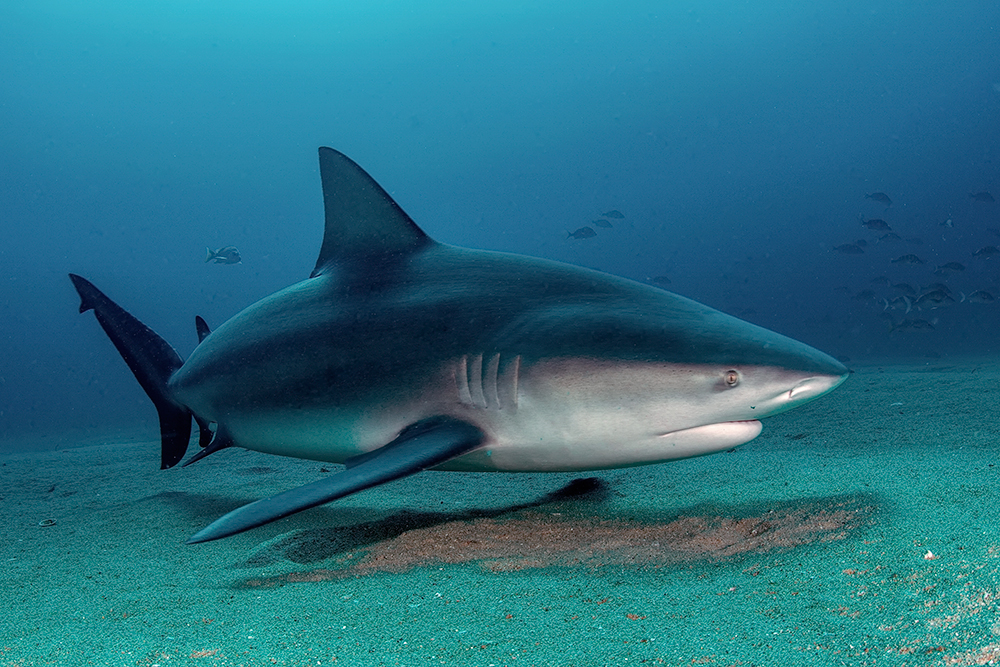
Day trips & Nearby dive locations from Cabo San Lucas
Yet another reason to include Cabo on your scuba diving bucket list is its proximity to numerous other diving hotspots.
Diving day trip options are plentiful on our peninsula meaning you can maximize your diving experience and explore a variety of underwater environments while having the opportunity to explore the beauty of the region.
Cabo Pulmo National Park
Where is Cabo Pulmo? Distance from Cabo San Lucas.
We can take you on a scenic coastal drive for about 81 miles (131km) north of Cabo, roughly two hours along the eastern side of the peninsula. Here you will reach Cabo Pulmo.
This easy day trip from Cabo San Lucas means a morning departure, two dives, lunch in Cabo Pulmo, and return to Cabo by evening.
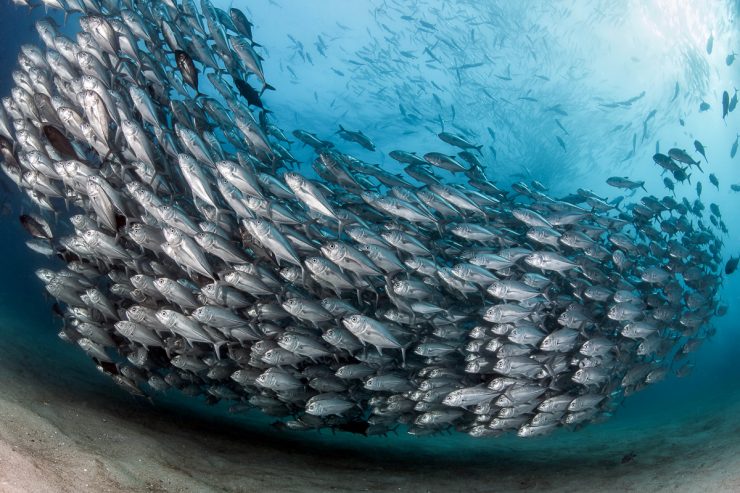
Diving in Cabo Pulmo, highlight
Cabo Pulmo stands out as an exceptional dive spot for several reasons. As a National Marine Park and UNESCO World Heritage site, it has global recognition as a Mission Blue Hope Spot.
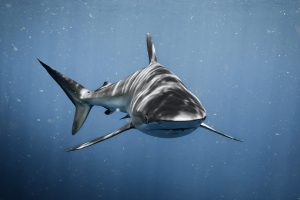
Its pristine coral reefs provide a habitat for diverse marine life, including the notorious bull sharks and renowned schools of tornado jack. These factors make Cabo Pulmo a must-see destination for diving enthusiasts seeking underwater thrills.
La Paz, Baja California
Where is La Paz, distance from Cabo San Lucas
Heading more into the Sea of Cortez, La Paz is located approximately 93 miles (150 km) from Cabo San Lucas.
La Paz is easily accessible by road via the highway through Todos Santos, also taking about a 2-hour drive with departures typically in the early morning.
Here you can enjoy two dives and have lunch in La Paz before returning to Cabo San Lucas in the evening, making it a convenient excursion.
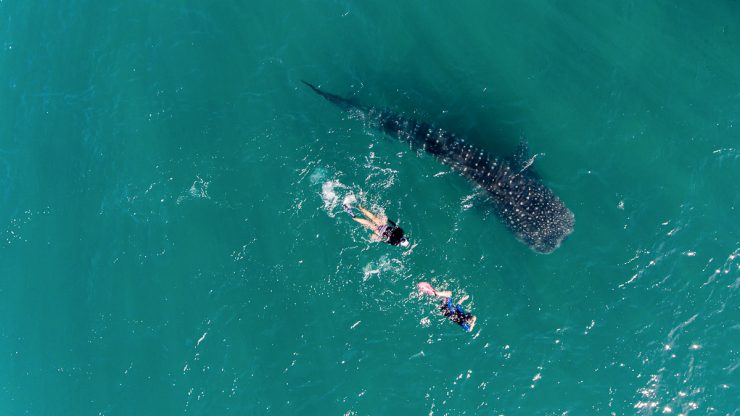
Highlight Diving in La Paz (Mexico)
Diving in La Paz offers heaps of unforgettable experiences, making it a must-visit destination for divers.
From November to April, you have the chance to swim with the ocean’s largest fish, the whale shark.
You can also dive and swim with one of the biggest sea lion colonies along our rocky shores at the UNESCO Marine Protected Area of San Rafaelito, or visit the stunning Isla Espíritu Santo.
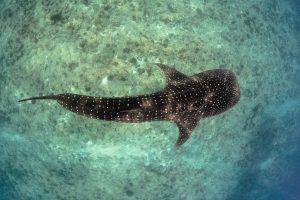
Additionally, you can explore three remarkable shipwrecks in La Paz—the Fang Ming wreck, a Chinese fishing vessel turned smuggling ship, and also the C59/USS Diploma wreck, and the Salvatierra shipwreck—each with its own unique history.
Whether you’re drawn to marine giants or exploring submerged relics, La Paz promises an underwater experience that will leave a lasting memory. But what is the best diving destination between Cabo and La Paz?
Cerralvo island (Jacques Cousteau island) & La Ventana
Cerralvo Island, also known as Jacques Cousteau Island, lies just 13 miles (21 Km) off the shore of La Ventana, a quaint fishing and kite surfing town.
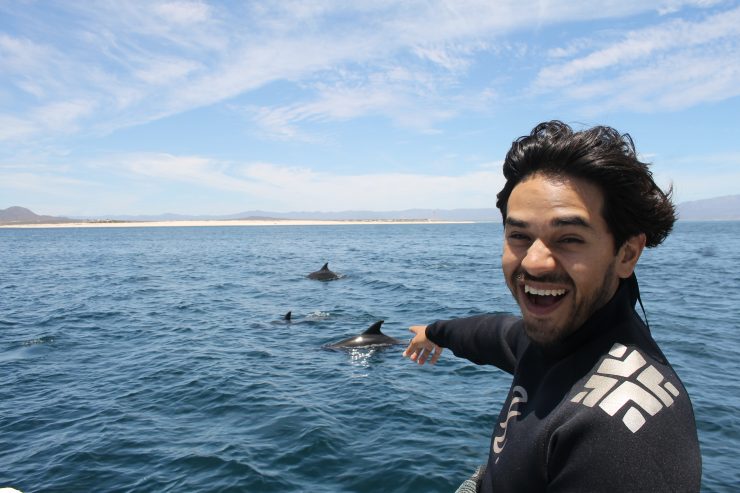
Highlight Diving in Cerralvo island (Mexico)
Renowned for its remarkable reef, “La Reina,” Cerralvo island attracts divers with the chance to encounter majestic pelagic mantas. This location is also home to the mobula ray aggregation in April – June, and even offer a chance to swim with wild dolphin !
Dive trips from Cabo San Lucas via Panga boat offer access to explore the beauty of this lesser-known underwater gem, making it an ideal destination for divers seeking awesome marine encounters away from the hustle and bustle of Cabo.
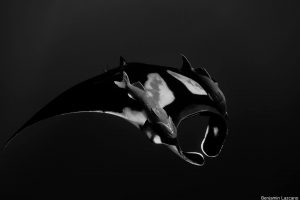
Loreto, Baja California Sur
Venturing farther from Cabo, Loreto lies 320 miles (500 km) away on the east coast, beside the Sea of Cortez.
There are some truly breathtaking landscapes with a backdrop of the Sierra de la Giganta mountain range.
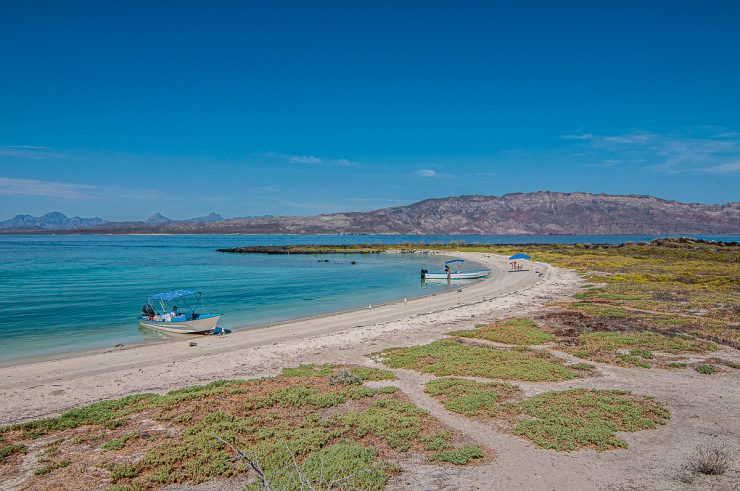
The waters here form part of the Bahía de Loreto National Park. Here, an abundance of marine life can be found, including mobula rays, mantas, whales, and even orcas, all amidst vibrant reef systems.
Loreto offers a blend of natural beauty and diverse marine ecosystems for divers to enjoy, making it a destination you should be considering.
Magdalena Bay & San Ignacio Lagoon
Magdalena Bay, on the west coast near Puerto San Carlos, is a truly lovely dive spot. 2250 miles (400 km) from Cabo San Lucas, it’s famous for the grey whale migration and the exciting Mexican sardine run.
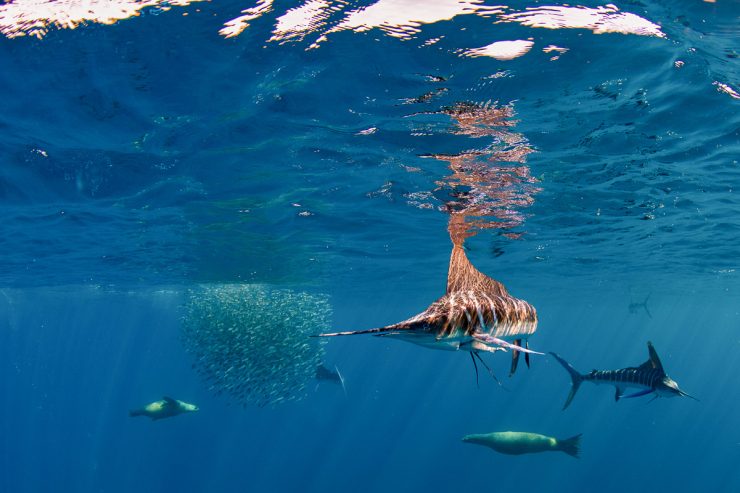
The bay’s calm waters, sheltered by small islands, host a variety of marine life, including striped marlin, sharks, sea lions, and seabirds. With its relaxed atmosphere and stunning wildlife, Magdalena Bay offers divers a delightful opportunity to explore the ocean in a tranquil setting.
Socorro Island liveaboard
Socorro Island is a stunning volcanic island and UNESCO heritage site, forming part of the Revillagigedo archipelago islands. Located 250 miles (400 km) southwest of Cabo San Lucas in the middle of the Pacific, the only access to diving there is via diving liveaboard trips lasting 8 to 12 days which leave from Cabo.
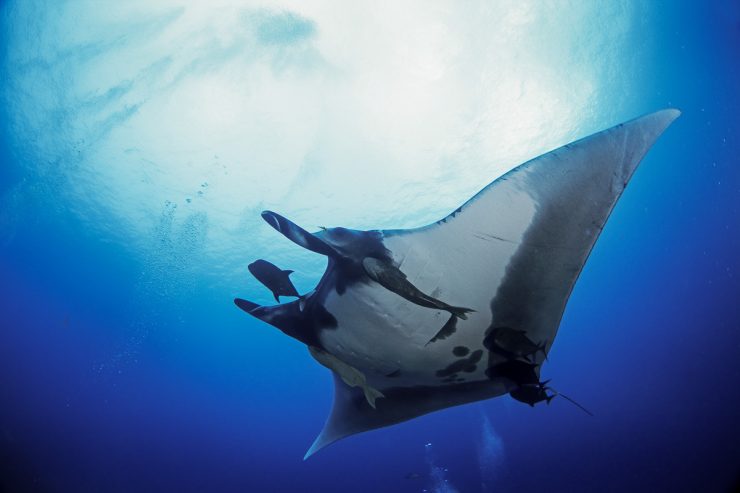
Many divers opt for a Liveaboard check-out dive in Cabo to refresh their skills before taking on this world-class diving adventure. This dive site is renowned for its pelagic biodiversity which includes manta rays, schools of hammerhead sharks, playful dolphins along with other majestic species.
Conclusion and takeaways
Why we love diving in Cabo San Lucas
We adore diving in Cabo San Lucas for its remarkable blend of pristine ecosystems, diverse marine life, and outstanding diving conditions.
The marine biodiversity is stunning, featuring soft coral reefs, schools of colorful fish, and encounters with majestic creatures like whale sharks, sea lions, hammerhead sharks, and mobula rays.
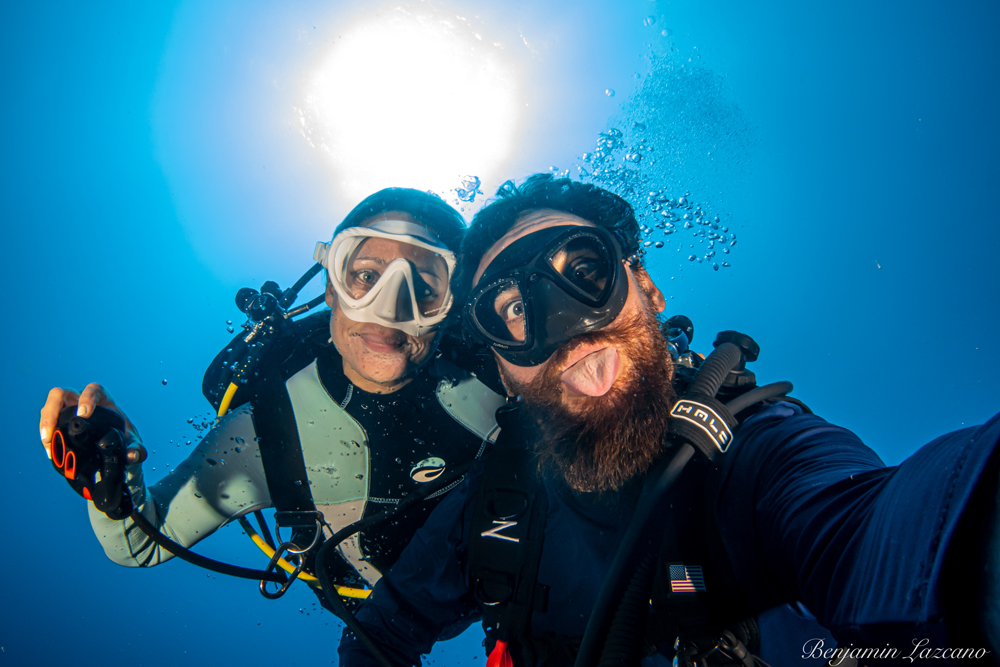
Catering to all skill levels, Cabo hosts diverse habitats, from shallow lagoons to underwater mounts and wreck dives.
The Pacific Ocean and the Sea of Cortez offer year-round diving opportunities, ensuring each dive is unique.
Its rich cultural heritage and vibrant atmosphere enhance the experience, making every dive memorable. Whether exploring iconic sites or hidden gems, diving in Cabo is always awe-inspiring.
Book Now
Sources & Credits
Credit photo and Video :
- Underwater Video by Cabo Private Guide team
- Underwater Photos by Laura Tyrrell, Benjamin Lazcano,Leonardo Gonzalez, Rui Duarte
Sources :


